#mine is dr strangelove 1964
Explore tagged Tumblr posts
Text
Lubna @rami-ajr91 and her lovely family need our help! She is a 30 year old mother of 3 children (Eline, 7 years old / Kinda, 3 years old / Nasser, 4 years old) Read her story here!
As you may already know, the price to feed and take care of her family in Gaza is astronomical, and Nasser, her middle child, was born without a thyroid gland and needs help with extra care for his medical condition. As you may know, there are no more facilities that can treat him at this time.
Here is proof of vetting and Nasser's medical records for you to check - this campaign has been vetted by @ gazavetters and several other trusted vetting accounts on here!
£4,675 raised out of £16K goal
Please, even if you can spare a little bit of money, we will be eternally grateful!! Thank you so much for sharing and donating :D your care and kindness are much appreciated
2K notes
·
View notes
Text
The 50 Best War Films of All Time

This is a tricky genre to try summarize, because of what each individual will choose to classify as a "war film", but I've done my best and tried to focus for the most part on stories set within the thick of actual warfare, rather than dramas taking place afterwards or behind the scenes, and except for a small number of impossible-to-ignore exceptions, very few comedies. Ranked and rated in loose order of quality, high-to-low:
Apocalypse Now (1979) ★★★★★★★★★★
All Quiet on the Western Front (1930) ★★★★★★★★★½
The Great Escape (1963) ★★★★★★★★★½
Ballad of a Soldier (1959) ★★★★★★★★★☆
Schindler's List (1993) ★★★★★★★★★☆
The Cranes Are Flying (1957) ★★★★★★★★★☆
The Boat (1981) ★★★★★★★★½☆
Saving Private Ryan (1998) ★★★★★★★★½☆
Catch-22 (1970) ★★★★★★★★½☆
The Last Bridge (1954) ★★★★★★★★½☆
The Deer Hunter (1978) ★★★★★★★★½☆
The Thin Red Line (1998) ★★★★★★★★½☆
The Killing Fields (1984) ★★★★★★★★½☆
Ice Cold in Alex (1958) ★★★★★★★★½☆
Lawrence of Arabia (1962) ★★★★★★★★½☆
The Bridge on the River Kwai (1957) ★★★★★★★★½☆
Wings (1927) ★★★★★★★★½☆
The Grand Illusion (1937) ★★★★★★★★½☆
Enemy at the Gates (2001) ★★★★★★★★☆☆
Three Kings (1999) ★★★★★★★★☆☆
Good Morning, Vietnam (1987) ★★★★★★★★☆☆
The Big Parade (1925) ★★★★★★★★☆☆
The Destiny of a Man (1959) ★★★★★★★★☆☆
The Bridge (1959) ★★★★★★★★☆☆
Army of Shadows (1969) ★★★★★★★★☆☆
Dr. Strangelove (1964) ★★★★★★★★☆☆
Full Metal Jacket (1987) ★★★★★★★★☆☆
The Burmese Harp (1956) ★★★★★★★★☆☆
Five Graves to Cairo (1943) ★★★★★★★★☆☆
Patton (1970) ★★★★★★★★☆☆
Napoleon (1927) ★★★★★★★★☆☆
The Wooden Horse (1950) ★★★★★★★★☆☆
Zulu (1964) ★★★★★★★½☆☆
Birdy (1984) ★★★★★★★½☆☆
1917 (2019) ★★★★★★★½☆☆
The Tin Drum (1979) ★★★★★★★½☆☆
Valkyrie (2008) ★★★★★★★½☆☆
The Human Condition I: No Greater Love (1959) ★★★★★★★½☆☆
The Human Condition III: A Soldier's Prayer (1961) ★★★★★★★½☆☆
M*A*S*H* (1970) ★★★★★★★½☆☆
Land of Mine (2015) ★★★★★★★½☆☆
The Hurt Locker (2008) ★★★★★★★☆☆☆
Gallipoli (1981) ★★★★★★★☆☆☆
Empire of the Sun (1987) ★★★★★★★☆☆☆
'71 (2014) ★★★★★★★☆☆☆
Born on the Fourth of July (1989) ★★★★★★★☆☆☆
Paths of Glory (1957) ★★★★★★★☆☆☆
Platoon (1986) ★★★★★★★☆☆☆
Breaker Morant (1980) ★★★★★★★☆☆☆
Inglourious Basterds (2009) ★★★★★★★☆☆☆

47 notes
·
View notes
Photo








If the spaghetti hits the fan, now we're really in trouble.
Dr. Strangelove or: How I Learned to Stop Worrying and Love the Bomb (1964) dir. Stanley Kubrick
#Dr. Strangelove or: How I Learned to Stop Worrying and Love the Bomb#dr strangelove#stanley kubrick#60s#filmedit#filmgif#filmgifs#1964#mine
89 notes
·
View notes
Text
Dr. Strangelove or: How I Learned to Stop Worrying and Love the Bomb (1964); AFI #39
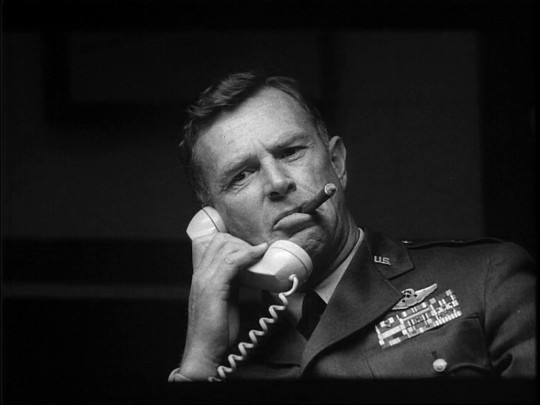

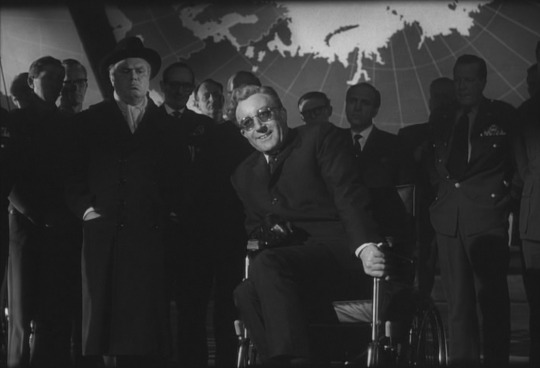
The most recent movie for the group to review was the Kubrick dark comedy, Dr. Strangelove (I am not writing out the whole title each time). This film has some of the most legitimately funny lines of bewilderment, with some occasions involving an actor playing across from himself. For most film goers, this will be Peter Seller’s most famous role since he plays three main characters, all with different accents, appearances, and quirks. The film was nominated for 4 Academy Awards (Best Picture, Best Director, Best Screenplay, and Best Actor) but did not take home any trophies. The film did win best picture at the BAFTAs. This film was definitely in the style of Kubrick, but it was in a genre that I don’t believe he delved into again. I want to review the plot before discussing further, so let me get the usual out of the way:
SPOILER ALERT!!! I AM ABOUT TO GIVE AWAY THE WHOLE PLOT OF THE FILM!!! IF YOU WANT TO WATCH THE FILM ON YOUR OWN WITHOUT HAVING ANYTHING SPOILED, STOP NOW AND WATCH THE FILM!!! YOU HAVE BEEN WARNED!!!
----------------------------------------------------------------------------
At the start, we are introduced to United States Air Force Brigadier General Jack D. Ripper (Sterling Hayden) who is commander of Burpelson Air Force Base. This base houses a group of B-52 bombers armed with hydrogen bombs that are constantly in the air. The planes are constantly within two hours from their targets inside the USSR in case of nuclear war. General Ripper orders his executive officer, Group Captain Lionel Mandrake of the UK Royal Air Force (Peter Sellers), to put the base on alert and to issue "Wing Attack Plan R" to the patrolling bombers, one of which is commanded by Major T. J. "King" Kong (Slim Pickens). All of the aircraft commence an attack flight on the USSR, and set their radios to allow communications only through their CRM 114 discriminators, which was designed to accept only communications preceded by a secret three-letter code known only to General Ripper. Mandrake discovers that no attack order has been issued by the Pentagon and tries to stop Ripper, who locks them both in his office. Ripper tells Mandrake that he believes the Soviets have been fluoridating American water supplies to pollute the "precious bodily fluids" of Americans. Mandrake realizes Ripper has gone insane.
In the War Room at the Pentagon, General Buck Turgidson (George C Scott) briefs President Merkin Muffley (Peter Sellers again) and other officers about how "Plan R" enables a senior officer to launch a retaliatory nuclear attack on the Soviets if all superiors have been killed in a first strike on the United States. It would take two days to try every CRM code combination to issue the recall order, but the planes are due to reach their targets within hours. Muffley orders the U.S. Army to storm the base and arrest General Ripper. Turgidson then attempts to convince Muffley to let the attack continue, but Muffley refuses. Instead, he brings Soviet ambassador Alexei de Sadeski (Peter Bull) into the War Room to telephone Soviet Premier Dimitri Kissov on the "hotline". Muffley warns the Premier of the impending attack, and offers to reveal the positions of the bombers and their targets so that the Soviets can protect themselves.
After a heated discussion in Russian with the Premier, the ambassador informs President Muffley that the Soviet Union had created a doomsday machine as a nuclear deterrent; it consists of many buried bombs jacketed with "cobalt-thorium G", which are set to detonate automatically should any nuclear attack strike the country. Within two months after detonation, the cobalt-thorium G would encircle the planet in a radioactive shroud that would render the Earth's surface uninhabitable. The device cannot be deactivated, as it is programmed to explode if any such attempt is made. The President's wheelchair-bound scientific advisor, former Nazi German Dr. Strangelove (Peter Sellers one more time), points out that such a doomsday machine would only be an effective deterrent if everyone knew about it; Alexei replies that the Soviet Premier had planned to reveal its existence to the world the following week.
Meanwhile, U.S. Army troops arrive at Burpelson, and General Ripper commits suicide. Mandrake identifies Ripper's CRM code from his desk blotter and relays it to the Pentagon. Using the code, Strategic Air Command successfully recalls all of the bombers except Major Kong's, whose radio equipment has been damaged in a missile attack. The Soviets attempt to find it, but Kong has the bomber attack a closer target due to dwindling fuel. As the plane approaches the new target, a Soviet ICBM site, the crew is unable to open the damaged bomb bay doors. Kong enters the bay and repairs the broken electrical wiring while sitting on a H-bomb, whereupon the doors open and the bomb is dropped. Kong joyfully straddles the bomb as it falls and detonates over the target.
Back in the War Room, Dr. Strangelove recommends that the President gather several hundred thousand people to live in deep underground mines where the radiation will not penetrate. He suggests a 10:1 female-to-male ratio for a breeding program to repopulate the Earth once the radiation has subsided. Worried that the Soviets will do the same, Turgidson warns about a "mineshaft gap" while Alexei secretly photographs the war room. Dr. Strangelove declares he has a plan, but then rises from his wheelchair and announces "Mein Führer, I can walk!" as the Doomsday Machine activates. The film ends with a montage of many nuclear explosions, accompanied by Vera Lynn's rendition of the song "We'll Meet Again".
---------------------------------------------------------------------------
This is a pretty weird film, but it has some of the funniest lines in cinema. Discussions of not letting a Russian envoy into the war room because he will “see the big board,” the president announcing there is no fighting in the war room, a crazy general constantly talking about a plot to steal American bodily fluids, and a discussion about how the high ranking officials and generals would be hidden in shelters with a 10-1 ratio of hot women to men with the expectation of constant impregnation which everybody suddenly favors: it is all absurd. But I really love it and laugh every time I watch.
The three roles of Peter Sellers is especially noteworthy, as all of his characters are so different. He plays a very British foreign exchange officer (I am not sure this exists), an absolutely whacky former Nazi scientist, and the straight man of the film in the form of the US president. Since Dr. Strangelove was an advisor to the president, there were many scenes in which Peter Sellers was acting across from a stunt shoulder or the back of a head that was supposed to be him. He did a fantastic job of making light of total world destruction during the cold war.
One very notable thing about the acting of Peter Sellers was that he had a couple of ad libs during the movie. Stanley Kubrick is not a director that particularly cares if he gets along with his actors, often times demanding dozens of takes for even the simplest of background scenes. Long dialogue scenes are repeated over and over to the point that many actors did not want to work with Kubrick. And still, the director seemed to like Sellers quite a bit and kept a couple of the takes that were ad-libbed, specifically for the character of Dr. Strangelove. Perhaps the crazy former Nazi character was so unpredictable that random whacky outbursts (like the scream for “Mein Fuhrer” at the end) seemed appropriate.
A little side note is that this was the first film appearance of James Earl Jones as one of the bombardiers on the B-52. He was known for his work in the theatre at the time, so of course he had a bit part in which he was mostly covered in a flight suit and said very little. Now that is a misuse of talent.
A point about the movie that I was unaware but was pointed out by a follower of the group was that the promotional material for the film shows that the plane was named “Leper Colony” (thank you @themightyfoo). This implies that this group was actually a bunch of screw ups, which is part of the overall joke that this group was given access to world ending bombing capabilities. Maybe it was assumed that the order to drop the bombs would never be given and this group was just given this detail to get them out of the way.
So does this movie belong on the AFI list? Yes, but maybe not ranked so high. It has a lot of name recognition, but I think that is more due to the very distinct naming and the titular role. Maybe the notoriety is also due to the subject matter and the time it was released. It is a fine film with great acting, but I find it hard to put above Jaws, Rocky, or Taxi Driver. I guess that is more my humble opinion, but I agree the list would be lacking without this film. So would I recommend it? Absolutely. It is an interesting story about how red tape allowed one high ranking individual to literally destroy the world. And it is a joke. It is such a well told story that they had to put a disclaimer at the front. A great lesson, even today.
#dr. strangelove#stanley kubrick#top 100#movies#black and white#nuclear war#cold war#dark comedy#peter sellers#george c. scott#introvert#introverts
23 notes
·
View notes
Text
The best movie quotes of all-time

Here are some of the best Hollywood movie quotes of all time. Talk about dramatic one-liners!
“Frankly, my dear, I don’t give a damn (Gone with the Wind, 1939)
“Here’s looking at you, kid” (Casablanca, 1942)
“You’re gonna need a bigger boat” (Jaws, 1975)
“May the Force be with you” (Star Wars, 1977)
“Toto, I’ve a feeling we’re not in Kansas anymore” (The Wizard of Oz, 1939)
“I’m going to make him an offer he can’t refuse” (The Godfather, 1972)
“Of all the gin joints in all the towns in all the world, she walks into mine.” (Casablanca, 1942)
“You talkin’ to me?” (Taxi Driver, 1976)
“There’s no place like home” (The Wizard of Oz, 1939)
“The first rule of Fight Club is you do not talk about Fight Club” (Fight Club, 1999)
“I am your father” (Star Wars: The Empire Strikes Back, 1980)
“Hello. My name is Inigo Montoya. You killed my father. Prepare to die.” (The Princess Bride, 1987)
“Why so serious?” (The Dark Knight, 2008)
“I’ll have what she’s having” (When Harry Met Sally, 1989)
“This is the beginning of a beautiful friendship” (Casablanca, 1942)
“We’ll always have Paris” (Casablanca, 1942)
“Bond. James Bond” (Dr No, 1962)
“I see dead people” (The Sixth Sense, 1999)
“I’ll be back” (The Terminator, 1984)
“You can’t handle the truth!” (A Few Good Men, 1992)
“E.T phone home” (ET, 1982)
“Yippie-ki-yay, mother f**ker!” (Die Hard, 1988)
“To infinity and beyond!” (Toy Story, 1995)
“Houston, we have a problem” (Apollo 13, 1995)
“You had me at hello” (Jerry Maguire, 1996)
“There’s no crying in baseball!” (A League of Their Own, 1992)
“Here’s Johnny!” (The Shining, 1980)
”I am serious. And don't call me Shirley.” (Airplane, 1980)

“Mrs. Robinson, you're trying to seduce me, aren't you?” (The Graduate, 1967)
“Carpe Diem. Seize the day, boys” (Dead Poets Society, 1989)
“Leave the gun, take the cannoli” (The Godfather, 1972)
“Show me the money!” (Jerry Maguire, 1996)
“Say hello to my little friend” (Scarface, 1983)
”You've got to ask yourself one question: 'Do I feel lucky?' Well, do ya punk?” (Dirty Harry, 1971)
“I love the smell of napalm in the morning.” (Apocalypse Now, 1979)
”Fasten your seatbelts. It's going to be a bumpy night.” (All About Eve, 1950)
“Roads? Where we're going we don't need roads.” (Back to the Future, 1985)
”You don't understand! I could've had class. I could've been a contender. I could've been somebody, instead of a bum, which is what I am.” (On the Waterfront, 1954)
“I'm as mad as hell, and I'm not going to take this anymore!” (Network, 1976)
”The greatest trick the devil ever pulled was convincing the world he didn't exist.” (The Usual Suspects, 1995)
“Keep your friends close, but your enemies closer.” (The Godfather Part II, 1974)
”Every time a bell rings, an angel gets his wings.” (It’s a Wonderful Life, 1946)
“I am big! It's the pictures that got small.” (Sunset Boulevard, 1950)
”What we've got here is a failure to communicate.” (Cool Hand Luke, 1967)
“Shaken, not stirred” (Goldfinger, 1964)
“I’m the king of the world!” (Titanic, 1997)
“Mama says, 'Stupid is as stupid does.’” (Forrest Gump, 1994)
“Just keep swimming (Finding Nemo, 2003)
“If you built it, he will come” (Field of Dreams, 1989)
“I'm not bad. I'm just drawn that way.” (Who Framed Roger Rabbit, 1988)
“I’m having an old friend for dinner” (The Silence of the Lambs, 1991)
”Play it, Sam. Play 'As Time Goes By.’“ (Casablanca, 1942)
”I'll get you, my pretty, and your little dog, too!” (The Wizard of Oz, 1939)
“Hasta la vista, baby” (Terminator 2: Judgement Day, 1991)
“The Dude abides” (The Big Lebowski, 1998)
“I'm also just a girl, standing in front of a boy, asking him to love her.” (Notting Hill, 1999)
”Pay no attention to that man behind the curtain!” (The Wizard of Oz, 1939)
“Stella! Hey, Stella!” (A Streetcar Named Desire, 1951)
“After all, tomorrow is another day!” (Gone with the Wind, 1939)
”You is kind. You is smart. You is important.” (The Help, 2011)
“You know how to whistle, don't you, Steve? You just put your lips together and blow.” (To Have and Have Not, 1944)
”Help me, Obi-Wan Kenobi. You're my only hope.” (Star Wars, 1977)
“I mean, funny like I'm a clown? I amuse you?” (Goodfellas, 1990)
“Go ahead, make my day” (Sudden Impact, 1983)
”I have always depended on the kindness of strangers.” (A Streetcar Named Desire, 1951)
“It’s alive! It’s alive!” (Frankenstein, 1931)
“Argo f**k yourself” (Argo, 2012)
“My precious” (The Lord of the Rings: The Two Towers, 2002)
“Good morning, Vietnam!” (Good Morning, Vietnam, 1987)
“I wish I knew how to quit you” (Brokeback Mountain, 2005)
“That’ll do, pig, that’ll do” (Babe, 1995)
“Elementary, my dear Watson” (The Adventures of Sherlock Holmes, 1939)
“I don't want to survive. I want to live.” (12 Years a Slave, 2013)
”Gentlemen, you can't fight in here! This is the war room!” (Dr Strangelove, 1964)

“You ain't heard nothin' yet!” (The Jazz Singer, 1927)
“Wax on, wax off” (The Karate Kid, 1984)
“Yo, Adrian!” (Rocky, 1976)
“Nobody’s perfect” (Some Like it Hot, 1959)
”Just when I thought I was out, they pull me back in.” (The Godfather Part III, 1990)
“Magic Mirror on the wall, who is the fairest one of all?” (Snow White and the Seven Dwarves, 1937)
“They’re here!” (Poltergeist, 1982)
”They call it a Royale with cheese.” (Pulp Fiction, 1994)
“I'm just one stomach flu away from my goal weight.” (The Devil Wears Prada, 2006)
”Badges? We ain't got no badges! We don't need no badges! I don't have to show you any stinking badges!” (The Treasure of the Sierra Madre, 1948)
“It was Beauty killed the Beast” (King Kong, 1933)
“I'm walking here! I'm walking here!” (Midnight Cowboy, 1969)
“These go to eleven” (This is Spinal Tap, 1984)
“Forget it, Jake. It’s Chinatown” (Chinatown, 1974)
“Chewie, we’re home” (Star Wars: The Force Awakens, 2015)
“As if!” (Clueless, 1995)
“You make me want to be a better man” (As Good as It Gets, 1997)
”Get your stinking paws off me, you damned dirty ape!” (Planet of the Apes, 1968)
“I drink your milkshake!” (There Will be Blood, 2007)
“My name is Maximus Decimus Meridius, commander of the Armies of the North, General of the Felix Legions and loyal servant to the true emperor, Marcus Aurelius. Father to a murdered son, husband to a murdered wife. And I will have my vengeance, in this life or the next.” (Gladiator, 2000)
“You complete me” (Jerry Maguire, 1996)
”If you let my daughter go now, that'll be the end of it. I will not look for you, I will not pursue you. But if you don't, I will look for you, I will find you, and I will kill you.” (Taken, 2008)
“When you realize you want to spend the rest of your life with somebody, you want the rest of your life to start as soon as possible.” (When Harry Met Sally, 1989)
“They call me Mister Tibbs!” (In the Heat of the Night, 1967)
”They may take our lives, but they'll never take our freedom!” (Braveheart, 1995)
“Love means never having to say you're sorry” (Love Story, 1970)
For plenty more dramatic content, check out www.dramabit.com.
4 notes
·
View notes
Text
A list of all films featured in 2020′s 31 Days of Oscar
This is the exhaustive list of all 327 short- and feature-length films featured during this year’s 31 Days of Oscar marathon (down from 388 in 2019, up from 296 in 2018). Every single film that was featured since January 29 was nominated for an Academy Award or won an Honorary Oscar. We started the marathon a few days early this year because of the earlier-than-usual timing of this year’s ceremony (which placed it at Day 12 of this year’s marathon). Thank goodness we’ll go back to usual in 2021 and 2022, where the former’s ceremony will be placed on Day 28 if I, by tradition, start the marathon on February 1, 2021.
Best Picture winners and the one (and only) winner for Unique and Artistic Production are in bold - okay the latter was not featured for this year’s marathon (but perhaps next time!). Asterisked (*) films are films I haven’t seen in their entirety as of the publishing of this post.
7th Heaven (1927)*
The Circus (1928)
The Divine Lady (1929)*
Disraeli (1929)*
The Love Parade (1929)*
All Quiet on the Western Front (1930)
Anna Christie (1930)*
The Divorcee (1930)*
The Green Goddess (1930)*
Raffles (1930)*
Five Star Final (1931)*
Little Caesar (1931)
The Sin of Madelon Claudet (1931)
Grand Hotel (1932)
One Hour with You (1932)*
Shanghai Express (1932)
Gold Diggers of 1933 (1933)
Little Women (1933)*
The Barretts of Wimpole Street (1934)*
The Gay Divorcee (1934)
It Happened One Night (1934)
The Thin Man (1934)
Bride of Frankenstein (1935)
The Lives of a Bengal Lancer (1935)*
Mutiny on the Bounty (1935)
Naughty Marietta (1935)
Top Hat (1935)
Broadway Melody of 1936 (1936)*
Fury (1936)*
The Garden of Allah (1936)
The Great Ziegfeld (1936)
Swing Time (1936)
Camille (1937)*
Grand Illusion (1937, France)
The Prisoner of Zenda (1937)
Three Smart Girls (1937)*
Wee Willie Winkie (1937)*
The Adventures of Robin Hood (1938)
Dark Victory (1939)
Gone with the Wind (1939)
Gunga Din (1939)
Ninotchka (1939)
Wuthering Heights (1939)*
All This, and Heaven Too (1940)
The Grapes of Wrath (1940)
The Philadelphia Story (1940)
Pinocchio (1940)
Rebecca (1940)
A Wild Hare (1940 short)
Blossoms in the Dust (1941)*
The Devil and Daniel Webster (1941)*
Hold Back the Dawn (1941)*
Lady Be Good (1941)*
Meet John Doe (1941)
Sergeant York (1941)
Casablanca (1942)
Der Fuehrer’s Face (1942 short)
In Which We Serve (1942)*
Now, Voyager (1942)
Road to Morocco (1942)
Yankee Doodle Dandy (1942)
Cabin in the Sky (1943)
Destination Tokyo (1943)*
A Guy Named Joe (1943)*
This Land is Mine (1943)*
Marie Curie (1943)*
The North Star (1943)*
The Song of Bernadette (1943)
The Yankee Doodle Mouse (1943 short)
Double Indemnity (1944)
Gaslight (1944)
Going My Way (1944)
It Happened Tomorrow (1944)*
Laura (1944)
National Velvet (1944)
The Uninvited (1944)*
Brief Encounter (1945)
Caesar and Cleopatra (1945)*
Leave Her to Heaven (1945)*
Pride of the Marines (1945)*
The Southerner (1945)
They Were Expendable (1945)*
Vacation from Marriages (1945)*
Great Expectations (1946)*
The Green Years (1946)*
The Strange Love of Martha Ivers (1946)*
The Bachelor and the Bobby-Soxer (1947)*
Black Narcissus (1947)
Crossfire (1947)
Gentleman’s Agreement (1947)
The Ghost and Mrs. Muir (1947)
Green Dolphin Street (1947)*
T-Men (1947)*
The Red Shoes (1948)
Romance on the High Seas (1948)*
It’s a Great Feeling (1949)*
A Letter to Three Wives (1949)*
Little Women (1949)*
Mighty Joe Young (1949)*
Neptune’s Daughter (1949)*
She Wore a Yellow Ribbon (1949)
The Third Man (1949)
All About Eve (1950)
La Ronde (1950, France)*
Ace in the Hole (1951)
An American in Paris (1951)
Quo Vadis (1951)
Royal Wedding (1951)
When Worlds Collide (1951)*
The Bad and the Beautiful (1952)
Le Plaisir (1952, France)*
Singin’ in the Rain (1952)
The Band Wagon (1953)
From Here to Eternity (1953)
Lili (1953)
Mogambo (1953)*
The Story of Three Loves (1953)*
La Strada (1954, Italy)
On the Waterfront (1954)
Seven Samurai (1954, Japan)
Bad Day at Black Rock (1955)
No Hunting (1955 short)*
Around the World in 80 Days (1956)
The Burmese Harp (1956, Japan)
Friendly Persuasion (1956)
Giant (1956)
Lust for Life (1956)
Somebody Up There Likes Me (1956)*
Written on the Wind (1956)*
Funny Face (1957)
Gunfight at the O.K. Corral (1957)
Tammy and the Bachelor (1957)*
12 Angry Men (1957)
Witness for the Prosecution (1957)
Cat on a Hot Tin Roof (1958)
Gigi (1958)
Separate Tables (1958)*
Ben-Hur (1959)
North by Northwest (1959)
The Young Philadelphians (1959)*
The Alamo (1960)
The Entertainer (1960)*
Pepe (1960)*
Spartacus (1960)
Two Women (1960, Italy)*
Beep Prepared (1961 short)
Days of Wine and Roses (1962)
How the West Was Won (1962)
Lawrence of Arabia (1962)
Sweet Bird of Youth (1962)
The Caretakers (1963)*
Cheyenne Autumn (1964)
Dr. Strangelove or: How I Learned to Stop Worrying and Love the Bomb (1964)
That Man from Rio (1964, France)*
My Fair Lady (1964)
Doctor Zhivago (1965)
The Shop on Main Street (1965, Czechoslovakia)*
The Sound of Music (1965)
A Funny Thing Happened on the Way to the Forum (1966)
A Man for All Seasons (1966)
The Professionals (1966)
Bonnie and Clyde (1967)
Cool Hand Luke (1967)
Far from the Madding Crowd (1967)*
The Graduate (1967)
The Jungle Book (1967)
The Producers (1967)
The Young Girls of Rochefort (1967, France)*
Funny Girl (1968)
Ice Station Zebra (1968)*
The Lion in Winter (1968)*
Planet of the Apes (1968)
True Grit (1969)
Z (1969, Algeria)
Dodes'ka-den (1970, Japan)
Woodstock (1970)
Carnal Knowledge (1971)*
The Emigrants (1971, Sweden)*
Cabaret (1972)
Cries and Whispers (1972, Sweden)
The Godfather (1972)
The Life and Times of Judge Roy Bean (1972)*
Travels with My Aunt (1972)*
Papillon (1973)
The Sting (1973)
The Four Musketeers (1974)*
The Godfather: Part II (1974)
Young Frankenstein (1974)
Dersu Uzala (1975, Soviet Union)
Dog Day Afternoon (1975)
Shampoo (1975)*
The Sunshine Boys (1975)*
Network (1976)
Taxi Driver (1976)
A Special Day (1977, Italy)*
Star Wars (1977)
Autumn Sonata (1978, Sweden)
Superman (1978)
The Swarm (1978)*
Kramer vs. Kramer (1979)
Star Trek: The Motion Picture (1979)
Kagemusha (1980, Japan)
Moscow Does Not Believe in Tears (1980, Soviet Union)*
An American Werewolf in London (1981)*
Mephisto (1981, Hungary)*
Annie (1982)
An Officer and a Gentleman (1982)*
Victor/Victoria (1982)
Educating Rita (1983)*
Terms of Endearment (1983)
Dune (1984)*
A Passage to India (1984)*
Out of Africa (1985)
Ran (1985, Japan)
Witness (1985)*
Aliens (1986)
Luxo Jr. (1986 short)
Empire of the Sun (1987)
The Last Emperor (1987)
Bull Durham (1988)*
Mississippi Burning (1988)*
Dead Poets Society (1989)
Field of Dreams (1989)
Dances with Wolves (1990)
Ghost (1990)*
Boyz n the Hood (1991)*
The Silence of the Lambs (1991)
Aladdin (1992)
Unforgiven (1992)
The Firm (1993)*
The Wrong Trousers (1993 short)*
Forrest Gump (1994)
Il Postino (1994, Italy)
Little Women (1994)*
Casino (1995)*
Toy Story (1995)
Emma (1996)*
Star Trek: First Contact (1996)
Life Is Beautiful (1997, Italy)
The Old Lady and the Pigeons (1997 short, France)*
Saving Private Ryan (1998)
The Insider (1999)
Toy Story 2 (1999)
Crouching Tiger, Hidden Dragon (2000, Taiwan)
Gladiator (2000)
Harry Potter and the Sorcerer’s Stone (2001)
A.I. Artificial Intelligence (2001)
The Lord of the Rings: The Fellowship of the Ring (2001)
The Crime of Padre Amaro (2002, Mexico)*
Treasure Planet (2002)
The Fog of War (2003)*
The Triplets of Belleville (2003, France)*
Howl’s Moving Castle (2004, Japan)
Walk the Line (2005)*
Babel (2006)*
The Departed (2006)
Letters from Iwo Jima (2006)
Atonement (2007)*
Ratatouille (2007)
The Hurt Locker (2008)
Kung Fu Panda (2008)
Waltz with Bashir (2008, Israel)
Precious (2009)*
The Secret of Kells (2009)
Inception (2010)
Toy Story 3 (2010)
A Separation (2011, Iran)
Amour (2012, Austria)
War Witch (2012, Canada)*
Omar (2013, Palestine)*
The Tale of the Princess Kaguya (2013, Japan)
12 Years a Slave (2013)
Timbuktu (2014, Mauritania)
Mad Max: Fury Road (2015)
Hidden Figures (2016)
Kubo and the Two Strings (2016)
Dear Basketball (2017 short)
Negative Space (2017 short)
The Shape of Water (2017)
BlacKkKlansman (2018)
Roma (2018, Mexico)
The nine nominees for Best Picture, including the winner, Parasite (2019, South Korea)
The fifteen nominees for the short film categories (2019)
Ad Astra (2019)
American Factory (2019)*
A Beautiful Day in the Neighborhood (2019)
For Sama (2019)*
Honeyland (2019, North Macedonia)*
How to Train Your Dragon: The Hidden World (2019)
I Lost My Body (2019, France)
Judy (2019)
Klaus (2019)
Knives Out (2019)
The Lighthouse (2019)
Pain and Glory (2019, Spain)
Rocketman (2019)
Star Wars: The Rise of Skywalker (2019)
Toy Story 4 (2019)
The Two Popes (2019)*
10 notes
·
View notes
Text
200+7 comedies
A film list for my dearest @volatilelovers. Dramedies, romantic comedies and satire are not excluded. Hope that some of them help you a little when you feel down.
So, here we go:
The Kid (1921) dir. Charlie Chaplin
Safety Last! (1923), dir. Harold Lloyd
The Navigator (1924), dir. Buster Keaton
The General (1926), dir. Clyde Bruckman, Buster Keaton
The Cameraman (1928), dir. Buster Keaton
The Circus (1928), dir. Charlie Chaplin
The Neighbor's Wife and Mine (1931), dir. Heinosuke Gosho
Duck Soup (1933), dir. Leo McCarey
Passing Fancy (1933), dir. Yasujiro Ozu
A Night at the Opera (1935), dir. Sam Wood
Modern Times (1936), dir. Charlie Chaplin
Mr. Thank You (1936), dir. Hiroshi Shimizu
A Day at the Races (1937), dir. Sam Wood
The Awful Truth (1937), dir. Leo McCarey
Bringing Up Baby (1938), dir. Howard Hawks
Ninotchka (1939), dir. Ernst Lubitsch
The Women (1939), dir. George Cukor
His Girl Friday (1940), dir. Howard Hawks
The Great Dictator (1940), dir. Charlie Chaplin
The Philadelphia Story (1940), dir. George Cukor
The Shop Around the Corner (1940), dir. Ernst Lubitsch
That Uncertain Feeling (1941), dir. Ernst Lubitsch
Arsenic and Old Lace (1944), dir. Frank Capra
The Big Day (1949), dir. Jacques Tati
Carmen Comes Home (1951), dir. Keisuke Kinoshita
The Machine to Kill Bad People (1952), dir. Roberto Rossellini
Mr. Hulot's Holiday (1953), dir. Jacques Tati
Roman Holiday (1953), dir. William Wyler
Welcome Mr. Marshall! (1953), dir. Luis García Berlanga
Days of Love (1954), dir. Giuseppe De Santis
Sabrina (1954), dir. Billy Wilder
The Ladykillers (1955), dir. Alexander Mackendrick
Summertime (1955), dir. David Lean
To Paris with Love (1955), dir. Robert Hamer
Elena and Her Men (1956), dir. Jean Renoir
Danger Stalks Near (1957), dir. Keisuke Kinoshita
Love in the Afternoon (1957), dir. Billy Wilder
The Smallest Show on Earth (1957), dir. Basil Dearden
Big Deal on Madonna Street (1958), dir. Mario Monicelli
Endless Desire (1958), dir. Shohei Imamura
Equinox Flower (1958), dir. Yasujirô Ozu
Rickshaw Man (1958), dir. Hiroshi Inagaki
My Uncle (1958), dir. Jacques Tati
The Great War (1959), dir. Mario Monicelli
The Mouse That Roared (1959), dir. Jack Arnold
Some Like It Hot (1959), dir. Billy Wilder
The Apartment (1960), dir. Billy Wilder
Love and Larceny (1960), dir. Dino Risi
Two-Way Stretch (1960), dir. Robert Day
Breakfast at Tiffany's (1961), dir. Blake Edwards
Divorce Italian Style (1961), dir. Pietro Germi
Killers on Parade (1961), dir. Masahiro Shinoda
Three Daughters (1961), dir. Satyajit Ray
Being Two Isn't Easy (1962), dir. Kon Ichikawa
Il Sorpasso (1962), dir. Dino Risi
The Executioner (1963), dir. Luis García Berlanga
The Twelve Chairs (1962), dir. Tomás Gutiérrez Alea
I mostri (1963), dir. Dino Risi
Yesterday, Today and Tomorrow (1963), dir. Vittorio De Sica
Dr. Strangelove (1964), dir. Stanley Kubrick
Marriage Italian Style (1964), dir. Vittorio De Sica
Seduced and Abandoned (1964), dir. Pietro Germi
Welcome, or No Trespassing (1964), dir. Elem Klimov
Adventures of a Dentist (1965), dir. Elem Klimov
A Boring Afternoon (1965), dir. by Ivan Passer
The Holy Man (1965), dir. Satyajit Ray
I Knew Her Well (1965), dir. Antonio Pietrangeli
Simon of the Desert (1965), dir. Luis Buñuel
Yoyo (1965), dir. Pierre Étaix
Daisies (1966), dir. Vera Chytilová
L'armata Brancaleone (1966), dir. Mario Monicelli
Morgan – A Suitable Case for Treatment (1966), dir. Karel Reisz
How to Steal a Million (1966), dir. William Wyler
What Did You Do in the War, Daddy? (1966), dir. Blake Edwards
The Firemen's Ball (1967), dir. Milos Forman
Two for the Road (1967), dir. Stanley Donen
The Party (1968), dir. Blake Edwards
Stolen Kisses (1968), dir. François Truffaut
Three Resurrected Drunkards (1968), dir. Nagisa Ôshima
The Cremator (1969), dir. Juraj Herz
Le Grand Amour (1969), dir. Pierre Étaix
The Magic Christian (1969), dir. Joseph McGrath
Brancaleone at the Crusades (1970), dir. Mario Monicelli
Between Miracles (1971), dir. Nino Manfredi
Money Money Money (1972), dir. Claude Lelouch
Roma (1972), dir. Federico Fellini
The Seduction of Mimi (1972), dir. Lina Wertmüller
We Won't Grow Old Together (1972), dir. Maurice Pialat
Amarcord (1973), dir. Federico Fellini
Love and Anarchy (1973), dir. Lina Wertmüller
The Cars That Ate Paris (1974), dir. Peter Weir
The Front Page (1974), dir. Billy Wilder
Scent of a Woman (1974), dir. Dino Risi
Swept Away (1974), dir. Lina Wertmüller
Young Frankenstein (1974), dir. Mel Brooks
Monty Python and the Holy Grail (1975), dir. Terry Gilliam, Terry Jones
Down and Dirty (1976), dir. Ettore Scola
Murder by Death (1976), dir. Robert Moore
Viva Italia! (1977), dir. Mario Monicelli, Dino Risi, Ettore Scola
A Wedding (1978), dir. Robert Altman
Being There (1979), dir. Hal Ashby
Monty Python's Life of Brian (1979), dir. Terry Jones
The Aviator's Wife (1981), dir. Éric Rohmer
A Good Marriage (1982), dir. Éric Rohmer
Educating Rita (1983), dir. Lewis Gilbert
The Meaning of Life (1983), dir. Terry Jones
Pauline at the Beach (1983), dir. Éric Rohmer
What Have I Done to Deserve This? (1984), dir. Pedro Almodóvar
Peggy Sue Got Married (1986), dir. Francis Ford Coppola
Shadows in Paradise (1986), dir. Aki Kaurismäki
Something Wild (1986), dir. Jonathan Demme
Babette's Feast (1987), dir. Gabriel Axel
Withnail and I (1987), dir. Bruce Robinson
Heart of a Dog (1988), dir. Vladimir Bortko
The Little Devil (1988). dir. Roberto Benigni
Women on the Verge of a Nervous Breakdown (1988), dir. Pedro Almodóvar
Histoires d'Amérique: Food, Family and Philosophy (1989), dir. Chantal Akerman
The Eagle Shooting Heroes (1993), dir. Jeffrey Lau
The Postman (1994), dir. Michael Radford, Massimo Troisi
Chungking Express (1994), dir. Wong Kar-wai
Fallen Angels (1995), dir. Wong Kar-wai
Big Night (1996), dir. Campbell Scott, Stanley Tucci
The Daytrippers (1996), dir. Greg Mottola
Deep Crimson (1996), dir. Arturo Ripstein
Career Girls (1997), dir. Mike Leigh
The Full Monty (1997), dir. Peter Cattaneo
Woman in Witness Protection (1997), dir. Jûzô Itami
Nine Queens (2000), dir. Fabián Bielinsky
O Brother, Where Art Thou? (2000), dir. Joel Coen, Ethan Coen
101 Reykjavík (2000), dir. Baltasar Kormákur
The Swamp (2001), dir. Lucrecia Martel
8 Women (2002), dir. François Ozon
About Schmidt (2002), dir. Alexander Payne
Chinese Odyssey (2002), dir. Jeffrey Lau
Divine Intervention (2002), dir. Elia Suleiman
Unknown Pleasures (2002), dir. Jia Zhangke
You Owe Me One (2002), dir. Carlos Cuarón
Good Bye Lenin! (2003), dir. Wolfgang Becker
Sideways (2004), dir. Alexander Payne
Broken Flowers (2005), dir. Jim Jarmusch
Me and You and Everyone We Know (2005), dir. Miranda July
Tristram Shandy: A Cock and Bull Story (2005), dir. Michael Winterbottom
Private Fears in Public Places (2006), dir. Alain Resnais
Volver (2006), dir. Pedro Almodóvar
Caramel (2007), dir. Nadine Labaki
In Search of a Midnight Kiss (2007), dir. Alex Holdridge
Happy-Go-Lucky (2008), dir. Mike Leigh
Mid-August Lunch (2008), dir. Gianni di Gregorio
A Rational Solution (2009), dir. Jörgen Bergmark
A Serious Man (2009), dir. Ethan Coen, Joel Coen
Looking for Eric (2009), dir. Ken Loach
Soul Kitchen (2009), dir. Fatih Akin
Mammuth (2010), dir. Gustave Kervern, Benoît Delépine
The Trip (2010), dir. Michael Winterbottom
The Haven (2011), dir. Aki Kaurismäki
The Intouchables (2011), dir. Olivier Nakache, Éric Toledano
Sidewalls (2011), dir. Gustavo Taretto
The Angels' Share (2012), dir. Ken Loach
Frances Ha (2012), dir. Noah Baumbach
Moonrise Kingdom (2012), dir. Wes Anderson
Wadjda (2012), dir. Haifaa Al-Mansour
I'm So Excited! (2013), dir. Pedro Almodóvar
Casse-tête chinois (2013), dir. Cédric Klapisch
Still Life (2013), dir. Uberto Pasolini
Vivir es fácil con los ojos cerrados (2013), dir. David Trueba
The Bélier Family (2014), dir. Éric Lartigau
Gemma Bovery (2014), dir. Anne Fontaine
The Grand Budapest Hotel (2014), dir. Wes Anderson
Infinitely Polar Bear (2014), dir. Maya Forbes
The Price of Fame (2014), dir. Xavier Beauvois
The Trip to Italy (2014), dir. Michael Winterbottom
The Voices (2014), dir. Marjane Satrapi
Love at First Fight (2014), dir. Thomas Cailley
While We're Young (2014), dir. Noah Baumbach
Wild Tales (2014), dir. Damián Szifron
Asphalte (2015), dir. Samuel Benchetrit
The Big Short (2015), dir. Adam McKay
Hello, My Name Is Doris (2015), dir. Michael Showalter
Maggie's Plan (2015), dir. Rebecca Miller
The Second Mother (2015), dir. Anna Muylaert
Taxi (2015), dir. Jafar Panahi
Captain Fantastic (2016), dir. Matt Ross
The Distinguished Citizen (2016), dir. Gastón Duprat, Mariano Cohn
Lost in Paris (2016), die. Dominique Abel, Fiona Gordon
Love & Friendship (2016), dir. Whit Stillman
Paterson (2016), dir. Jim Jarmusch
Perfetti sconosciuti (2016), dir. Paolo Genovese
You're Killing Me Susana (2016), dir. Roberto Sneider
Pikadero (2015), dir. Ben Sharrock
Their Finest (2016), dir. Lone Scherfig
Toni Erdmann (2016), dir. Maren Ade
The Announcement (2017), dir. Fazil Coşkun
The Other Side of Hope (2017), dir. Aki Kaurismäki
Let the Sunshine In (2017), dir. Claire Denis
Sir (2018), dir. Rohena Gera
Secret Ingredient (2017), dir. Gjorce Stavreski
The Big Sick (2017), dir. Michael Showalter
The Disaster Artist (2017), dir. James Franco
An Unexpected Love (2018), dir. Juan Vera
Diamantino (2018), dir. Gabriel Abrantes, Daniel Schmidt
My Masterpiece (2018), dir. Gaston Duprat
The Square (2018), dir. Ruben Östlund
Tel Aviv on Fire (2018), dir. Sameh Zoabi
The Interpreter (2018), dir. Martin Šulík
Thunder Road (2018), dir. Jim Cummings
Woman at War (2018), dir. Benedikt Erlingsson
The Two Popes (2019), dir. Fernando Meirelles
P.S. Sorry for any typos.
2 notes
·
View notes
Text
OSCARS
Legenda:
Legenda - Winners I have watched
Legenda - Winners I don’t know of
Legenda - Winners I know of
Legenda - Nominees I have watched
Legenda - Nominees I don’t know of
Legenda - Nominees I know of
1927/28
BEST MOVIE
Wings
The Racket
7th Heaven
= 0
BEST ACTRESS
Janet Gaynor:
for her role as Diane Angela, The Wife in 7th Heaven and Street Angel Sunrise: A Song of Two Humans
Louise Dresser:
for her role as Mrs. Pleznik in A Ship Comes In
Gloria Swanson:
for her role as Sadie Thompson in Sadie Thompson
1928/29
BEST MOVIE
The Broadway Melody
Alibi
Hollywood Revue
In Old Arizona
The Patriot
= 0
Mary Pickford:
for her role as Norma Besant in Coquette
Ruth Chatterton:
for her role as Jacqueline Floriot in Madame X
Betty Compson:
for her role as Carrie in The Barker
Jeanne Eagels:
for her role as Leslie Crosbie in The Letter
Corinne Griffith:
for her role as Emma Hamilton in The Divine Lady
Bessie Love:
for her role as Hank Mahoney in The Broadway Melody
1929/30
BEST MOVIE
All Quiet on the Western Front
The Big House
Disraeli
The Divorcee
The Love Parade
= 0
Norma Shearer:
for her role as Jerry Bernard Martin in The Divorcee
Nancy Carroll:
for her role as Hallie Hobart in The Devil’s Holiday
Ruth Chatterton:
for her role as Sarah Storm in Sarah and Son
Greta Garbo:
for her role as Anna Christie/Madame Rita Cavallini in Anna Christie Romance
Norma Shearer:
for her role as Lucia Marlett in Their Own Desire
Gloria Swanson:
for her role as Marion Donnell in The Trespasser
1930/31
BEST MOVIE
Cimarron
East Lynne
The Front Page
Skippy
Trader Horn
= 0
Marie Dressler:
for her role as Min Divot in Min and Bill
Marlene Dietrich:
for her role as Mademoiselle Amy Jolly in Morocco
Irene Dunne:
for her role as Sabra Cravat in Cimarron
Ann Harding:
for her role as Linda Seton in Holiday
Norma Shearer:
for her role as Jan Ashe in A Free Soul
1931/32
BEST MOVIE
Grand Hotel
Arrowsmith
Bad Girl
The Champ
Five Star Final
One Hour with You
Shanghai Express
The Smiling Lieutenant
= 0
Helen Hayes:
for her role as Madelon Claudet in The Sin of Madelon Claudet
Marie Dressler:
for her role as Emma Thatcher Smith in Emma
Lynn Fontanne:
for her role as The Actress in The Guardsman
1932/33
BEST MOVIE
Cavalcade
42nd Street
A Farewell to Arms
I Am a Fugitive from a Chain Gang
Lady for a Day
Little Women
The Private Life of Henry VIII
She Done Him Wrong
Smilin’ Through
State Fair
= 0
BEST ACTRESS
Katharine Hepburn:
for her role as Eva Lovelace in Morning Glory
May Robson:
for her role as Apple Annie in Lady for a Day
Diana Wynyard:
for her role as Jane Marryot in Cavalcade
1934
BEST MOVIE
It Happened One Night
The Barretts of Wimpole Street
Cleopatra
Flirtation Walk
The Gay Divorcee
Here Comes the Navy
The House of Rothschild
Imitation of Life
One Night of Life
The Thin Man
Viva Villa!
The White Parade
= 0
BEST ACTRESS
Claudette Colbert:
for her role as Ellie Andrews in It Happened One Night
Grace Moore:
for her role as Mary Barrett in One Night of Love
Norma Shearer:
for her role as Elizabeth Barrett in The Barrett of Wimpole Street
Bette Davis:
for her role as Mildred Rogers in Of Human Bondage
1935
BEST MOVIE
Munity on the Bounty
Alice Adams
Broadway Melody of 1936
Captain Blood
David Copperfield
The Informer
The Lives of a Bengal Lancer
A Midsummer Night’s Dream
Les Misérables
Naughty Marietta
Rugs of Red Gap
Top Hat
= 0
BEST ACTRESS
Bette Davis:
for her role as Joyce Heath in Dangerous
Elisabeth Bergner:
for her role as Gemma Jones in Escape Me Never
Claudette Colbert:
for her role as Jane Everest in Private Words
Katharine Hepburn:
for her role as Alice Adams in Alice Adams
Miriam Hopkins:
for her role as Becky Sharp in Becky Sharp
Merle Oberon:
for her role as Kitty Vane in The Dark Angel
1936
BEST MOVIE
The Great Ziegfeld
Anthony Adverse
Dodsworth
Libeled Lady
Mr. Deeds Goes to Town
Romeo and Juliet
San Francisco
The Story of Louis Pasteur
A Tale of Two Cities
Three Smart Girls
= 0
BEST ACTRESS
Luise Rainer:
for her role as Anna Held in The Great Ziegfeld
Irene Dunne:
for her role as Theodora Lynn in Theodora Goes Wild
Gladys George:
for her role as Carrie Snyder in Valiant is the Word for Carrie
Carole Lombard:
for her role as Irene Bullock in My Man Godfey
Norma Shearer:
for her role as Juliet Capulet in Romeo and Juliet
1937
BEST MOVIE
The Life of Emile Zola
The Awful Truth
Captain Courageous
Dead End
The Good Earth
In Old Chicago
Lost Horizon
One Hundred Men and a Girl
Stage Door
= 0
BEST ACTRESS
Luise Rainer:
for her role as O-Lan in The Good Earth
Irene Dunne:
for her role as Lucy Warriner in The Awful Truth
Greta Garbo:
for her role as Marguerite Gautier in Camille
Janet Gaynor:
for her role as Esther Victoria Blodgett/Vicki Lester in A Star is Born
Barbara Stanwyck:
for her role as Stella Martin Dallas in Stella Dallas
1938
BEST MOVIE
You Can’t Take It With You
The Adventures of Robin Hood
Alexander’s Ragtime Band
Boys Town
The Citadel
Four Daughters
Grand Illusion
Jezebel
Pygmalion
Test Pilot
= 0
BEST ACTRESS
Bette Davis:
for her role as Julie Marsden in Jezebel
Fay Bainter:
for her role as Hannah Parmalee in White Banners
Wendy Hiller:
for her role as Eliza Doolittle in Pygmalion
Norma Shearer:
for her role as Marie Antoinette in Marie Antoinette
Margaret Sullavan:
for her role as Patricia “Pat” Hollmann in Three Comrades
1939
BEST MOVIE
Gone With The Wind
Dark Victory
Goodbye, Mr. Chips
Love Affair
Mr. Smith Goes to Washington
Ninotchka
Of Mice and Men
Stagecoach
The Wizard of Oz
Wuthering Heights
= 0
BEST ACTRESS
Vivien Leigh:
for her role as Scarlett O’Hara in Gone with the Wind
Bette Davis:
for her role as Judith Traherne in Dark Victory
Irene Dunne:
for her role as Terry McKay in Love Affair
Greta Garbo:
for her role as Nina Yakushnova “Ninotchka” Ivanoff” in Ninotchka
Greer Garson:
for her role as Katherine Bridges in Goodbye, Mr. Chips
1940
BEST MOVIE
Rebecca
All This, and Heaven Too
Foreign Correspondent
The Grapes of Wrath
The Great Dictator
Kitty Foyle
The Letter
The Long Voyage Home
Our Town
The Philadelphia Story
= 0
BEST ACTRESS:
Ginger Rogers:
for her role as Kitty Foyle in Kitty Foyle
Bette Davis:
for her role as Leslie Crosbie in The Letter
Joan Fontaine:
for her role as The Second Mrs. de Winter in Rebecca
Katharine Hepburn:
for her role as Tracy Lord in The Philadelphia Story
Martha Scott:
for her role as Emily Webb in Our Town
1941
BEST MOVIE
How Green Was My Valley
Blossoms in the Dust
Citizen Kane
Here Comes Mr. Jordan
Hold Back the Dawn
The Little Foxes
The Maltese Falcon
One Foot in Heaven
Sargeant York
Suspicion
= 0
BEST ACTRESS:
Joan Fontaine:
for her role as Lina McLaidlaw Aysgarth in Suspicion
Bette Davis:
for her role as Regina Giddens, The Little Foxes
Olivia de Havilland:
Emmy Brown, Hold Back the Dawn
Greer Garson, Blossoms in the Dust
Barbara Stanwyck, Ball of Fire
1942
BEST MOVIE
Mrs. Miniver
The Invaders
Kings Row
The Magnificent Ambersons
The Pied Piper
The Pride of the Yankees
Random Harvest
The Talk of the Town
Wake Island
Yankee Doodle Dandy
= 0
BEST ACTRESS:
Greer Garson, Mrs. Miniver
Bette Davis, Now, Voyager
Katharine Hepburn, Woman of the Year
Rosalind Russel, My Sister Eileen
Teresa Wright, The Pride of the Yankees
1943
BEST MOVIE
Casablanca
For Whom the Bell Tolls
Heaven Can Wait
The Human Comedy
In Which We Serve
Madame Curie
The More the Merrier
The Ox-Bow Incident
The Song of Bernadette
Watch on the Rhine
= 0
BEST ACTRESS:
Jennifer Jones, The Song of Bernadette
Jean Arthur, The More the Merrier
Ingrid Bergman, For Whom the Bell Tolls
Joan Fontaine, The Constant Nymph
Greer Garson, Madame Curie
1944
BEST MOVIE
Going My Way
Double Indemnity
Gaslight
Since You Went Away
Wilson
= 0
BEST ACTRESS:
Ingrid Bergman, Gaslight
Claudette Colbert, Since You Went Away
1945
BEST MOVIE
The Lost Weekend
Anchors Aweigh
The Bells of St. Mary’s
Mildred Pierce
Spellbound
= 0
1946
BEST MOVIE
The Best Years of Our Lives
Henry V
= 0
1947
BEST MOVIE
Gentleman’s Agreement
The Bishop’s Wife
Crossfire
Great Expectations
Miracle on 34th Street
= 0
1948
BEST MOVIE
Hamlet
Johnny Belinda
The Red Shoes
The Snake Pit
The Treasure of the Sierra Madre
= 0
1949
BEST MOVIE
All the King’s Men
Battleground
The Heiress
A Letter to Three Wives
Twelve O’Clock High
= 0
1950
BEST MOVIE
All About Eve
Born Yesterday
Father of the Bride
King Solomon’s Mines
Sunset Boulevard
= 0
1951
BEST MOVIE
An American In Paris
Decision Before Dawn
A Place in the Sun
Quo Vadis
A Streetcar Named Desire
= 0
1952
BEST MOVIE
The Greatest Show on Earth
High Noon
Ivanhoe
Moulin Rouge
The Quiet Man
= 0
1953
BEST MOVIE
From Here to Eternity
Julius Caesar
The Robe
Roman Holiday
Shane
= 1
1954
BEST MOVIE
On The Waterfront
The Caine Mutiny
The Country Girl
Seven Brides for Seven Brothers
Three Coins in the Fountain
= 0
1955
BEST MOVIE
Marty
Love is a Many-Splendored Thing
Mister Roberts
Picnic
The Rose Tattoo
= 0
1956
BEST MOVIE
Around the World in 80 Days
Friendly Persuasion
Giant
The King and I
The Ten Commandments
= 0
1957
BEST MOVIE
The Bridge On The River Kwai
12 Angry Men
Peyton Place
Sayonara
Witness for the Prosecution
= 0
1958
BEST MOVIE
Gigi
Auntie Mame
Cat on a Hot Tin Roof
The Defiant Ones
Separate Tables
= 0
1959
BEST MOVIE
Ben-Hur
Anatomy of a Murder
The Diary of Anne Frank
The Nun’s Story
Room at the Top
= 0
1960
BEST MOVIE
The Apartment
The Alamo
Elmer Gantry
Sons and Lovers
The Sundowners
= 0
1961
BEST MOVIE
West Side Story
Fanny
The Guns of Navarone
The Hustler
Judgment at Nuremberg
= 1
1962
BEST MOVIE
Lawrence of Arabia
The Longest Day
The Music Man
Mutiny on the Bounty
To Kill a Mockingbird
= 0
1963
BEST MOVIE
Tom Jones
America America
Cleopatra
How the West Was Won
Lilies of the Field
= 0
1964
BEST MOVIE
My Fair Lady
Becket
Dr. Strangelove or: How I Learned to Stop Worrying and Love the Bomb
Mary Poppins
Zorba the Greek
= 1
1965
BEST MOVIE
The Sound of Music
Darling
Doctor Zhivago
Ship of Fools
A Thousand Clowns
= 1
1966
BEST MOVIE
A Man for All Seasons
Alfie
The Russians Are Coming, the Russians Are Coming
The Sand Pebbles
Who’s Afraid of Virginia Wolf
= 0
1967
BEST MOVIE
In the Heat of the Night
Bonnie and Clyde
Doctor Dolittle
The Graduate
Guess Who’s Coming to Dinner
= 0
1968
Oliver!
Funny Girl
The Lion in Winter
Rachel, Rachel
Romeo and Juliet
= 1
1969
BEST MOVIE
Midnight Cowboy
Anne of the Thousand Days
Butch Cassidy and the Sundance Kid
Hello, Dolly!
Z
= 0
1970
BEST MOVIE
Patton
Airport
Five Easy Pieces
Love Story
M*A*S*H
= 0
1971
BEST MOVIE
The French Connection
A Clockwork Orange
Fiddler on the Roof
The Last Picture
Nicholas and Alexandra
= 0
1972
BEST MOVIE
The Godfather
Cabaret
Deliverance
The Emigrants
Sounder
= 0
1973
BEST MOVIE
The Sting
American Graffitti
Cries and Whispers
The Exorcist
A Touch of Class
= 0
1974
BEST MOVIE
The Godfather Part II
Chinatown
The Conversation
Lenny
The Towering Inferno
= 0
1975
BEST MOVIE
One Flew Over The Cuckoo’s Nest
Barry Lyndon
Dog Day Afternoon
Jaws
Nashville
= 0
1976
BEST MOVIE
Rocky
All the President’s Men
Bound for Glory
Network
Taxi Driver
= 0
1977
BEST MOVIE
Annie Hall
The Goodbye Girl
Julia
Star Wars
The Turning Point
= 0
1978
BEST MOVIE
The Deer Hunter
Coming Home
Heaven Can Wait
Midnight Express
An Unmarried Woman
= 0
1979
BEST MOVIE
Kraver vs. Kramer
All That Jazz
Apocalypse Now
Breaking Away
Norma Rae
= 1
1980
BEST MOVIE
Ordinary People
Coal Miner’s Daughter
The Elephant Man
Raging Bull
Tess
= 0
1981
BEST MOVIE
Chariots of Fire
Atlantic City
On Golden Pond
Raiders of the Lost Ark
Reds
= 0
1982
BEST MOVIE
Ghandi
E.T. the Extra-Terrestrial
Missing
Tootsie
The Verdict
= 1
1983
BEST MOVIE
Terms of Endearment
The Big Chill
The Dresser
The Right Stuff
Tender Mercies
= 0
1984
BEST MOVIE
Amadeus
The Killing Fields
A Passage to India
Places in the Heart
A Soldier’s Story
= 0
1985
BEST MOVIE
Out of Africa
The Color Purple
Kiss of the Spider Woman
Prizzi’s Honor
Witness
= 0
1986
BEST MOVIE
Platoon
Children of a Lesser God
Hannah and Her Sisters
The Mission
A Room with a View
= 0
1987
BEST MOVIE
The Last Emperor
Broadcast News
Fatal Attraction
Hope and Glory
Moonstruck
= 2
1988
BEST MOVIE
Rain Man
The Accidental Tourist
Dangerous Liaisons
Mississipi Burning
Working Girl
= 0
1989
BEST MOVIE
Driving Miss Daisy
Born on the Fourth of July
Dead Poets Society
Field of Dreams
My Left Foot
= 1
1990
BEST MOVIE
Dances with Wolves
Awakenings
Ghost
The Godfather III
Goodfellas
= 1
1991
BEST MOVIE
The Silence of the Lambs
Beauty and the Beast
Bugsy
JFK
The Prince of Tides
= 1
1992
BEST MOVIE
Unforgiven
The Crying Game
A Few Good Men
Howards End
Scent of a Woman
= 0
1993
BEST MOVIE
Schindler’s List
The Fugitive
In the Name of the Father
The Piano
The Remains of the Day
= 1
1994
BEST MOVIE
Forrest Gump
Four Weddings and a Funeral
Pulp Fiction
Quiz Show
The Shawshank Redemption
= 3
1995
BEST MOVIE
Braveheart
Apollo 13
Babe
The Postman (Il Postino)
Sense and Sensibility
= 4
1996
BEST MOVIE
The English Patient
Fargo
Jerry McGuire
Secrets & Lies
Shine
= 0
1997
BEST MOVIE
Titanic
As Good as it Gets
The Full Monty
Good Will Hunting
L.A. Confidential
= 3
1998
BEST MOVIE
Shakespeare in Love
Elizabeth
Life is Beautiful
Saving Private Ryan
The Thin Red Line
= 3
1999
BEST MOVIE
American Beauty
The Cider House Rules
The Green Mile
The Insider
The Sixth Sense
= 1
2000
BEST MOVIE
Gladiator
Chocolat
Crouching Tiger, Hidden Dragon
Erin Brokovich
Traffic
= 3
2001
BEST MOVIE
A Beautiful Mind
Gosfrod Park
In the Bedroom
The Lord of the Rings: The Fellowship of the Ring
Moulin Rouge!
= 1
2002
BEST MOVIE
Chicago
Gangs of New York
The Hours
The Lord of the Rings: The Two Towers
The Pianist
= 1
2003
BEST MOVIE
The Lord of the Rings: The Return of the King
Lost in Translation
Master and Commander: The Far Side of the World
Mystic River
Seabiscuit
= 0
2004
BEST MOVIE
Million Dollar Baby
The Aviator
Finding Neverland
Ray
Sideways
= 1
2005
BEST MOVIE
Crash
Brokeback Mountain
Capote
Good Night, and Good Luck
Munich
= 0
2006
BEST MOVIE
The Departed
Babel
Letters from Iwo Jima
Little Miss Sunshine
The Queen
= 2
2007
BEST MOVIE
No Country for Old Men
Atonement
Juno
Michael Clayton
There Will Be Blood
= 1
2008
BEST MOVIE
Slumdog Millionaire
The Curious Case of Benjamin Button
Frost/Nixon
Milk
The Reader
= 1
2009
BEST MOVIE
The Hurt Locker
Avatar
The Blind Side
District 9
An Education
Inglorious Basterds
Precious: Based on the Novel “Push” by Saphire
A Serious Man
Up
Up in the Air
= 4
2010
BEST MOVIE
The King’s Speech
127 Hours
Black Swan
The Fighter
Inception
The Kids Are All Right
The Social Network
Toy Story 3
True Grit
Winter’s Bone
= 5
2011
BEST MOVIE
The Artist
The Descendants
Extremely Loud & Incredibly Close
The Help
Hugo
Midnight in Paris
Moneyball
The Tree of Life
War Horse
= 3
2012
BEST MOVIE
Argo
Amour
Beasts of the Southern Wild
Django Unchained
Les Miserábles
Life of Pi
Lincoln
Silver Linings Playbook
Zero Dark Thirty
= 4
2013
BEST MOVIE
12 Years a Slave
American Hustle
Captain Philips
Dallas Buyers Club
Gravity
Her
Nebraska
Philomena
The Wolf of Wall Street
= 4
2014
BEST MOVIE
Birdman
American Sniper
Boyhood
The Grand Budapest Hotel
The Imitation Game
Selma
The Theory of Everything
Whiplash
= 2
2015
BEST MOVIE
Spotlight
The Big Short
Bridge of Spies
Brooklyn
Mad Max: Fury Road
The Martian
The Revenant
Room
= 3
BEST ACTRESS:
Brie Larson, Room
Cate Blanchett, Carol
Jennifer Lawrence, Joy
Charlotte Rampling, 45 Years
Saoirse, Brooklyn
2016
BEST MOIVE
Moonlight
La La Land
Arrival
Fences
Hacksaw Ridge
Hell or High Water
Hidden Figures
Lion
Manchester by the Sea
= 5
BEST ACTRESS:
Emma Stone, La La Land
Isabelle Huppert, Elle
Ruth Negga, Loving
Natalie Portman, Jackie
Meryl Streep, Florence Foster Jenkins
2017
BEST MOVIE
The Shape of Water
Lady Bird
Call Me by Your Name
Get Out
Darkest Hour
Dunkirk
Phantom Thread
The Post
Three Billboards Outside Ebbig, Missouri
= 4
BEST ACTRESS:
Frances McDormand, Three Billboards Outside Ebbing, Missouri
Sally Hawkins, The Shape of Water
Margot Robbie, I, Tonya
Saoirse Ronan, Lady Bird
Meryl Streep, The Post
TOTAL = 71/
7 notes
·
View notes
Text
The Masque of the Red Death: Roger Corman Talks Pandemics and Restoration
https://ift.tt/3pjWssJ
During the 2020 lockdowns and ongoing COVID-19 pandemic, people at home sought isolated comfort. News reports continued to count the number of dead while people in charge downplayed its seriousness or offered dubious advice on dealing with the disease. It certainly didn’t interrupt many golf games. As workers were furloughed from jobs, they binged. One of the movies at the top of the playlist was The Masque of the Red Death, Roger Corman’s 1964 low budget masterpiece.
It told the tale of a wealthy medieval prince in a country decimated by an epidemic. The satanic overlord, played by the legendary actor and horror icon Vincent Price, locks his gates to his god-fearing dominions while he and his friends party like it’s 1999.
Edgar Allan Poe’s “The Masque of the Red Death” is about 2,300 words. Corman’s adaptation, which has been fully restored and can now be seen in its lush, psychedelic splendor, padded it with more Poe to reach 90 minutes. The screenplay by Charles Beaumont and R. Wright merged the tale with Poe’s “Hop Frog,” along with elements of the short story “Torture by Hope” by Auguste Villiers de l’Isle-Adam.
The devilish revelries came deep into a filmmaking cycle that began with American International Pictures executives Samuel Z. Arkoff and James Nicholson asking their in-house director Roger Corman to make two black-and-white horror films at $100,000 each. At the time, Corman had been producing tightly budgeted horror, science fiction, and juvenile delinquency quickies. With this opportunity, he pitched one film based upon Edgar Allan Poe’s “The Fall of the House of Usher,” saying it would move AIP to up in the motion picture world, as the studio was regarded as the maker of exploitation pictures.
It was the first of a cycle of eight films. Poe is read in every high school and is part of America’s literary canon; Corman’s Poe cycle made the writer an international gothic horror fan favorite.
The Masque of The Red Death was the seventh in Corman’s series. The adaptation also stars Jane Asher (Alfie, Death At A Funeral), Hazel Court (The Premature Burial, The Raven), David Weston (Becket, The Red Baron), and Nigel Green (Jason And The Argonauts, Zulu).
The 4K restoration of the extended cut of The Masque Of The Red Death was done by Martin Scorsese’s Film Foundation, and the Academy of Motion Picture Arts and Sciences. Additional funding came from the Hobson/Lucas Family Foundation. The Masque of the Red Death opened the same year as Stanley Kubrick’s nuclear nightmare Dr. Strangelove or: How I Learned to Stop Worrying and Love the Bomb. The fallout from an atomic war would result in a Red Death among survivors. Corman’s take on Poe was seen as a comment on the collateral damage of the Cold War, but it is a film which bridges generations of apocalyptic omens.
We spoke with Corman about the timeliness of his classic adaptation, as well as about stars Price and Asher, cinematographer Nicholas Roeg, and why Corman continues to find different delivery systems for message pictures.
Den of Geek: The last time we spoke, it was right before the inauguration. You had put Malcolm McDowell in funny hair and made him the president of the United Corporations of America. At the time, you said you hadn’t expected Trump to win. Today is the day after his (second) impeachment. Now that 2020 turned out to be a death race, did you expect him to be President Prospero?
Roger Corman: No. I assumed that [Joe] Biden was going to win. The polls all indicated that he was ahead. The polls have not always been correct, but in this case, they were so much in his favor, I assumed he was going to win.
Was there a conscious effort to put out The Masque of Red Death during the COVID-19 crisis with him as president?
Yes. Masque of the Red Death, in the United States, was on one of the platform streaming services, and the ratings on it went way up during COVID, because it was so appropriate. It’s actually more pertinent today than when it was made, because we do have the equivalent of the Red Death pandemic that is killing people all over the world.
In Masque of the Red Death, Prince Prospero brings together his friends, aristocrats and so forth, and they hold themselves up in the castle, to prevent the Red Death from killing them. And we have a somewhat similar situation today.
For instance, Trump is very careful. He claimed that the coronavirus was overrated. As a matter of fact, he said there was no such thing as coronavirus; it was “a hoax” perpetrated by the Democrats to make him look bad. But at the same time he was saying that, he was holed up in the lighthouse, going up primarily only to play golf or to hold big rallies. People were not protected within the rallies, but he himself made a real point of staying away from the crowd, to be on the stage and let the crowd get together and kill themselves, which they did.
The Mar-a-Lago of Red Death.
The Masque of the Mar-a-Lago.
Is it hard to keep a social distance when you’re squirming around on a floor like a worm?
It’s a little difficult, I would believe.
Vincent Price’s voice is beautiful in this movie. This is one of his most seductive parts. How quickly did he capture the character, from rehearsal to shooting?
He had the character pretty much set in mind when he came into it. Vincent always did a great deal of preparation. So what we would do [is] we would discuss the characters, just Vincent and me, before the rehearsals. He and I were in agreement on the character, and then he would bring that character to the rehearsals. We did not do a great deal of rehearsing because of the Screen Actors Guild rules. They charge you as if you are shooting when you rehearse.
Do you remember any notes you had to give him?
This is so long ago. It’s a little bit difficult to remember. But as I remember, I said, “The real key to Prospero’s character is that he believes God is dead.” And everything stems from that belief. That with the absence of God, he was free to do anything he wanted.
Did he always talk like that, like when he was ordering a bagel?
It was pretty much his normal voice. He added a certain drama to [lines], but basically that was Vincent. He was a highly educated man and very intelligent, so he spoke very well. And we simply heightened that somewhat in the films.
The film suffered some major censorship from the Legion of Decency, and the package booklet points out there was church involvement. Did you ever wonder whether you might be going to hell?
No, that never occurred to me. I’m sort of a lapsed Catholic, and I don’t believe there is a hell.
Is Red Death a disease or a sin?
The Red Death is a disease. That’s one of the reasons that’s a plague. You could consider it to be the Black Death of the Middle Ages. It would be the equivalent of coronavirus today.
In the booklet which comes with the DVD, it says that Father Miraliotta said the occult parts of the screenplay were “strung together gibberish” and “mumbo-jumbo Latin.” But did any of the satanic rituals have any validity?
No. We made up pretty much what we wanted. Actually, there were two writers, Chuck Beaumont and Bob Campbell, and I think it started with my discussions with Chuck.
How was Jane Asher to work with?
Jane Asher was wonderful to work with. She was a very young girl. She had worked on the stage. I think she was in the Young Shakespeare Group. And I don’t know if it was her first picture or not, but she was very good. She was an excellent actress and very good and easy to work with.
She was dating Paul McCartney when this was made, and her brother was a musician and a producer. Did you get to experience any Swinging London in-crowd during shooting?
A little bit. As a matter of fact, I can tell you a true story. Jane and I used to have lunch together in the studio commissary. And on a Thursday, she said a friend of hers was traveling through, on his way to London the next day. Would it be all right if he came and watched a shooting during the morning, and we could all have lunch together? And I said, “Sure, fine.”
Read more
Culture
When Paul McCartney Braved the Set of Roger Corman’s The Masque of the Red Death
By Tony Sokol
So, I got a director’s chair, sitting next to mine, during the shooting. And it was a nice, young guy, and we talked during the shooting. And I explained to him a little bit between shots how it all worked. And then we all, Jane and he, and I, had lunch together. And it all went very well. I said at the end of it, “Jane tells me you’re going to London. What are you going to be doing in London?”
He said, “Well, I’m with a singing group from Liverpool, and we’re going to be making our debut tomorrow night in London.” He was very cool. He knew that as an American, I didn’t know who The Beatles were or what he was. And as he left, I said, “Well, good luck, Paul, on your debut in London tomorrow night.”
And I remember he was very cool. He understood and he didn’t want to say, “Listen, buddy, we’re the number one group.” He just said, “Well, we’re a singing group.”
And then I saw the paper Sunday morning headlines, “Beatles conquer London.”
Did he ever come back to the set again?
No. But it was very funny. We were at an Academy Award party, which was I think the Vanity Fair party, which was a big thing, of people who were invited and so forth. We were at the Vanity Fair party, and I saw across the room Paul McCartney. And I said, “Oh, there’s Paul over there.”
And my wife, Julie, said, “Let’s go over and talk to him.” And I said, “No. I had lunch with him 60 years or so ago. He isn’t going to remember some guy he had lunch with 60 years ago, and I don’t want to intrude.” because he was in a conversation.
And Julie said, “Well, I want to meet Paul McCartney.” So, she went over and talked to him, and he came over to see me. As he approached, he said, “Masque of the Red Death.” He knew exactly where we’d met.
I interviewed William Shatner a few months ago and I asked about The Intruder, a piece he’s still very proud of. What draws you to consistently infuse your works, in any genre, with at least social questioning?
I’ve always been on the left, liberal side of politics. The Intruder was a time when the desegregation of schools in the South started. The schools in the South had maintained separate schools for Blacks. They were separate, but equal. And the Supreme Court ruled they were separate, but they were not equal, which was correct. They were inferior, and schools had to be integrated rather than keeping them separate. And it caused tremendous rebellion in the South. Chuck Beaumont, who worked with me on a number of pictures, had written the book The Intruder about an agitator, a little bit like somewhere between Joe McCarthy and Trump, who comes in, talking about patriotism and being against integration.
And I bought that book, The Intruder, and made it with Bill Shatner. It was his first picture. He was a Broadway actor, and he just came to Hollywood, and he was wonderful to work with, and the picture got incredible reviews. I’m trying to think of one of them, which was really good. Oh, it said, “The Intruder is a major credit to the entire American film industry.” And it won a couple of awards at minor festivals nobody ever heard of, but it was the first picture I ever made that lost money.
You consistently do social commentary in your work. What brings you back to it?
I stayed with it, but I tried to analyze why The Intruder got such wonderful reviews and such a great reaction, but the audience didn’t come to see it. And I thought, “I think I was too serious in this.” It was almost like delivering a message. And I remember years ago, some Hollywood producer said, “If you want to send a message, use Western Union.” And I thought, “I broke that rule.” And I thought, “I forgot that motion pictures are really basically an entertainment.”
So, from there on in, I used motion pictures as an entertainment, but as a subtext, with whatever theme or thought I was interested in. But first and foremost, the audience came to see and got the entertainment they paid to see. And as a bonus, as it were, there was the subtext, which sometimes was so slender that people didn’t get it. But [some] people got it. That was fine with me.
The restoration is really beautiful. I’d like to ask about the look. Your translation of Poe’s colors. Nicolas Roeg was the cinematographer. What was that collaboration like?
It went very well. It was the first I had done in England, except for a Formula One racing picture, which was in England and a number of other places. And they showed me a work of a number of English cameramen, and I thought Nic was the best of the group. And the collaboration went very well. I thought he did really, a brilliant job of camera work.
Afterwards he became a director. I never knew, did I inspire him to be a director, or did he feel if Roger can do it, anybody can do it?
So, he didn’t actually go through the Corman school of directors. I know you never produced any of his films.
I did not. He did it on his own.
You shot Masque on the set of Becket. What was different about having that as a cinematic playground, as opposed to shooting Saint Valentine’s Day Massacre?
It wasn’t really the set of Becket. What it is, Danny Heller, my art director, and I, always went to what was called a scene dock in studios where we’re going to work. The scene dock contained flats from previous pictures, just individual flats. Each of the pictures we shot in the United States, we were shooting at small rental studios, and the flats were not particularly impressive, but Danny would use them in the designs of sets.
When we did Masque of the Red Death, we found these magnificent flats from Becket. So they were not the sets, but we used those flats, and used them as an integral part of the sets.
Masque of Red Death was one of the first films that you had a longer shooting schedule. What was the first aspect of filmmaking that you noticed was affected by the extra time?
Well, two things. The English crews were very good. They were fully equal to the Hollywood crews, but they worked a little bit slower than the Hollywood crews. So I had a five-week schedule, whereas I had a three-week schedule in Hollywood. And I always thought I really had a four-week schedule, because we were working a little slowly.
Also, when we’d show up to work at 11:00, we would stop for elevenses. And then we would stop for lunch. And then in the middle of the afternoon, we would stop for tea. And I remember mentioning, I’ve forgotten who the assistant director was, but I said, “We’re spending half the day eating here. We should be shooting.”
But he said, “Well, this is the way we do it.”
In 2009, you made the Joe Dante series, Splatter, and each episode was shot in a week based on audience votes. Was that reminiscent of your early days of shooting on the 10-day schedules?
No. By that time, when I first started, although I did shoot a number of films in five or six days, in one picture, The Little Shop of Horrors, in two days. But my general schedule was two weeks when we started. As we moved along, starting with The Fall of the House of Usher, the first of the Poe pictures, I had three-week schedules. And our standard schedule for everything at that time was three weeks, so it was shot on a three-week schedule.
Did you really edit Little Shop of Horrors during a lunch break?
No. I shot Little Shop of Horrors in two days with a little bit of night shooting. So I’d say maybe two-and-a-half days. What happened, I had an office at a small rental studio in Hollywood and I was having lunch with the head of the studio. And he mentioned they had just finished a fairly big, slightly bigger budget picture. It was still low budget, and they had this really good, big set of an office. And I said, “Can you leave that up for a little while?” And he said, “Sure. We’ll leave it up until somebody comes in and rents the stage. And we’ll tear it down and put up the new set.”
So, after lunch, I went over and looked at it. And it was really a very good set, and I said [that] I was sort of experimenting with the concept of comedy and horror combined. And I thought, “It might be fun.”
I didn’t have a great deal of money at that time and nobody was going to back me with what I wanted to do. I thought, “I could shoot a picture here. And since almost everything is within this set, what I could do, I could shoot it in a couple of days, based upon this.”
Read more
Movies
Little Shop Of Horrors & the Tale of its Lost Ending
By Seb Patrick
Movies
The Roger Corman Fantastic Four Movie: The Most Faithful FF Ever
By Mike Cecchini
Screen Actors Guild salary structure was such that if you hired a person for a day, he got more money than one-fifth of what the weekly structure was. So I thought what I’ll do is hire everybody for a week. We’ll rehearse Monday, Tuesday, and Wednesday, because everything is in this set. And with everything set up, we can come and shoot on two days, on Thursday and Friday, which is what we did. And the whole thing was done sort of as an experimental lark.
It was quite successful. They made a Broadway play out of it and one thing and another, and a musical. And one of the reasons I think it was so successful was that none of us were taking it seriously. We were taking it and just sort of fooling around and having fun. And I think that attitude helped the picture, because the crew had the same attitude, and the whole thing permeated the shooting.
I remember we started shooting Thursday morning at 8:00. And at 8:30, the assistant director announced we were hopelessly behind schedule.
What are your favorite genres to shoot, and are they the same ones as the ones you watch?
Not particularly. I should watch more genre films to keep up with it. Actually, I watch a certain number, specifically to keep up and see what’s going on now. But I’m more inclined towards somewhat more serious films, and particularly foreign films, although I see fewer foreign films now than I did before. I don’t know why.
We were a production/distribution company, New World, which I founded in 1970, and we distributed for Fellini, Bergman, Kurosawa, Volker Schlöndorff, François Truffaut, a number of others. And I was a great fan of those films and went out of my way to distribute them. I was very much interested in that type of film.
In your early films, were you watching Mario Bava to see what he was doing? And were you expanding on that?
Actually, I saw only one film by Mario Bava, who incidentally I think was a brilliant filmmaker. It was because Jim Nicholson, who was the head of American International, had seen the film and liked Barbara Steele in it. He suggested I see the film and possibly use Barbara Steele.
I saw that one film. I don’t remember the name of it, but I thought it was really excellent. And indeed, I did bring Barbara Steele over. I think it was The Pit and the Pendulum. She played the leading lady.
What did Poe bring to your storytelling that, say, Lovecraft’s adaptations didn’t provide?
Well Poe, and this was part of my interpretation of Poe, I think Poe was working with the unconscious mind, from a writer’s standpoint, the same way that Freud, a little later in the same century, was working from a medical standpoint. I think the concept of the unconscious mind was starting to influence thinking in the 19th century, so I always thought that Poe represented the unconscious mind, and I shot according to that. It was one of my themes.
For instance, I felt the unconscious mind doesn’t really see the world. The conscious mind sees the world with eyes, ears, and so forth, and simply transmits information. So I made a point on all of the Poe films of never going outside unless I absolutely had to do it. I wanted to have full control, to shoot within the studio. Whether it came through to the audience, I don’t know. But at least in my own mind, I was able to deal with special effects with a number of things, with the concept of the unconscious mind.
When I did go outside, I tried to make it something that was not normal. For instance, on the very first picture, The Fall of the House of Usher, the only exterior sequence is when a man, played by Mark Damon, rides through a forest on his way to the House of Usher. And before we were shooting, there was a forest fire in the Hollywood Hills. I saw a picture of it in the Los Angeles Times, and all of the trees were burned. Everything was covered with ash, and I immediately put together, I think, a three or four-man crew. And we were up there in the Hollywood, burnt out hills, showing Mark on his horse, riding through that exterior.
I also used the ocean, a number of times. I feel that essentially, we came out of the ocean, and I felt somehow there is something fascinating about the ocean, even today.
Hazel Court’s invocation sequence is exquisite. When you were putting it together, were you having fun experimenting, trying to capture the unconscious mind?
Yes, it was all of the above. It dealt with the unconscious. We were experimenting, and I was having a lot of fun. I give a lot of credit to Danny Heller, the art director on that, because he would construct certain backgrounds. I would then work with different colored lenses on the camera, and then we would go in to a special effects shop, and they would take what I’d shot and overlay certain images. It was just a lot of fun putting them together, but I think I used that concept in almost every one of the Poe films.
And then of course, many, many years later, when I did The Trip, which was about an LSD experience, I really went crazy with those sequences.
On the other hand, I have to say this, at the time they came out, I got a lot of critical praise for that. But if you look at them today, they look primitive because the special effects today are so brilliant and so far advanced, that not only my pictures, but everybody was pictures at that time, when we used special effects, there was no way we could get the effects you can get today.
What do you think we’ve lost from the Mitchell cameras and having to lug things around and meticulously put together special effects? What do you think is lost in technology making filmmaking easier?
What’s gained is the fact that the special effects are just beyond anything anybody ever dreamed of before. They’re just astonishing. What is lost is the fact that there’s a tendency for the special effects to take over the picture, and the story and the characters are secondary to the special effects. And we’ve lost that to a certain extent. I wouldn’t say all the way, but we’ve lost to a certain extent the examination of characterization and the simple narrative, and the writing of dialogue.
How do you work with your composers on your films?
I work with composers probably a little less than most directors do. I don’t pretend to have great knowledge of music. What I do [is] I talk with the composer and discuss the themes, the mood within each individual scene, the basic feeling I want from the music, and then I leave it to him.
For instance, directors are generally on the soundstage when they’re recording the music. I’m never there. I’m not a conductor. I leave that to the composer.
The last movie you directed was Frankenstein Unbound in 1990. What would it actually take to put you back in the director’s seat?
Well, what happened was because when I started in 1970, I started my own production/distribution company. And I had planned simply to take a year off from directing, because I was just tired. I’d directed about 60 films in about maybe 15, 16 years. And I thought I would take a sabbatical, one year off from directing, and just be a producer and a head of the company. But then the company became instantaneously successful.
It was really amazing. Our very first picture was a giant success, and so were all of the following ones. And I got so involved in all of that [that] I just stepped away from directing. But then Universal did some kind of research, and they came up with the idea that “Roger Corman’s Frankenstein” would be a success for a film, and they asked me if I would like to make it, to produce and direct it. And I said, “No. You may have that research, but in my opinion, it’s just going to be another Frankenstein film. There have been so many Frankenstein films. It isn’t worth going back.”
But they kept coming back to me, and they offered me so much money. Finally, I thought, “Geez, I’d be an idiot not to turn this opportunity down for what they’re now offering me.” And I said, “All right, I can’t say yes right now. But if I can find a new version, something that is a different interpretation of Frankenstein, I will do it.”
And I read a novel, Frankenstein Unbound, by Brian Aldiss, a very good English science fiction and fantasy writer. And it was a story of somebody from the future, who, through a time warp, is thrown back into the 19th century and meets Dr. Frankenstein.
In the novel, he was some sort of a diplomat. But in the movie, I changed him from being a diplomat to a scientist, so that the picture essentially brought a 21st century scientist back to meet a 19th century scientist. And I thought that was an original and new interpretation. So I said, “If you can buy that novel, I’ll make the picture.” Which we did.
With all the streaming alternatives now for new projects, do you think it’s easier for an independent director to break in, or is it still just the same corporate-owned studio stuff?
I think you would divide that into two sections. It’s a little bit more difficult today, particularly with the studios, because they’re making now primarily these giant special effects pictures, and they’re not going to give a new director a chance to play with a $200 million budget.
But new directors are breaking in pretty much the way they were when I started, which is on independent films and particularly on low budget films.
You’re both the producer and the director on Masque. Were there things that you wanted to do as a director that you wouldn’t let yourself do as a producer?
I was a producer and director on almost all of my films, so I never really had any problems with the producer. If there was a problem with the producer, it was a problem with myself.
cnx.cmd.push(function() { cnx({ playerId: "106e33c0-3911-473c-b599-b1426db57530", }).render("0270c398a82f44f49c23c16122516796"); });
The Masque of the Red Death is available on Blu-ray, DVD, and Digital now.
The post The Masque of the Red Death: Roger Corman Talks Pandemics and Restoration appeared first on Den of Geek.
from Den of Geek https://ift.tt/2Mnk6X1
0 notes
Text
LUCY GETS HER MAN
S1;E21 ~ February 24, 1969
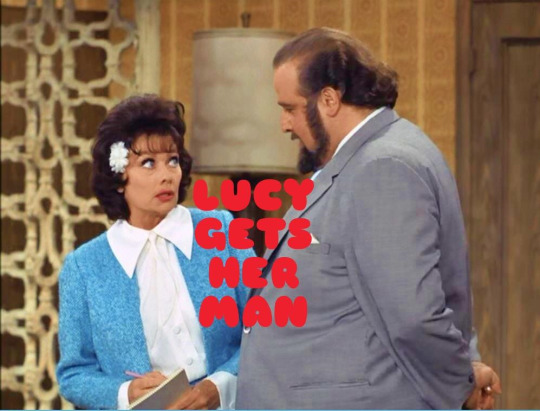
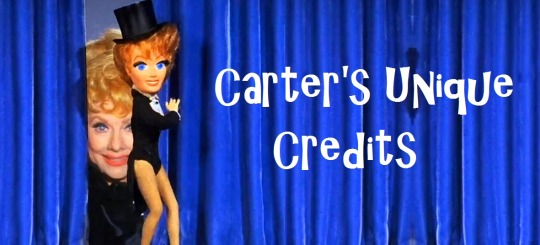
Directed by Jack Donohue ~ Written by Fred S. Fox and Seaman Jacobs
Synopsis
Harry's old Army buddy is working in Counter-Intelligence and needs a stenographer to help get the goods on a suspected spy (Victor Buono). Naturally, Lucy gets the assignment.
Regular Cast
Lucille Ball (Lucy Carter), Gale Gordon (Harrison Otis Carter), Lucie Arnaz (Kim Carter), Desi Arnaz Jr. (Craig Carter)
Guest Cast
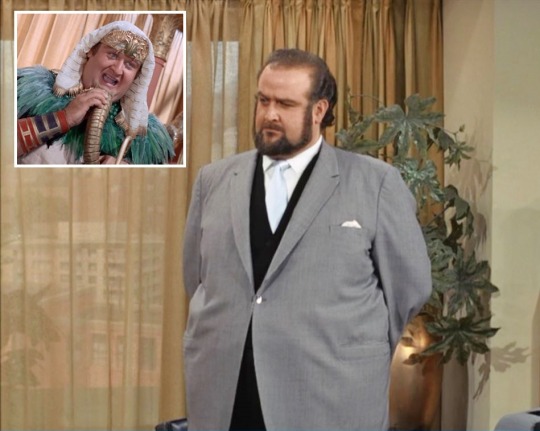
Victor Buono (Arthur Vermillion) was a character actor whose screen career began in 1959. He was nominated for a 1963 Oscar for his portrayal of Edwin Flagg in Whatever Happened To Baby Jane, which he quickly followed up with Hush, Hush Sweet Charlotte, both starring Bette Davis. He is perhaps best remembered for playing arch-villain King Tut on “Batman” (inset). Buono died in 1982 at the age of 43.
Buono uses a thick middle-European accent as Vermillion. According to the dictionary, ‘vermillion’ (or ‘vermilion’), describes a deep, brilliant shade of red. ‘Red’ is slang for a communist, based on the color of the communist flag, which ties into the spy theme of the episode.
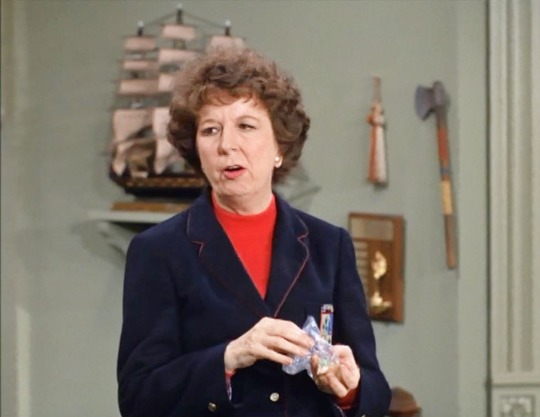
Mary Wickes (Isabel) was one of Lucille Ball’s closest friends and at one time, a neighbor. She made a memorable appearances on “I Love Lucy” as ballet mistress Madame Lamond in “The Ballet” (ILL S1;E19). In her initial “Lucy Show” appearances her characters name was Frances, but she then made four more as a variety of characters for a total of 8 episodes. This is the first of her 9 appearances on “Here’s Lucy.” She also played Isabel in “Lucy Goes on Strike” (S1;E16). Their final collaboration on screen was “Lucy Calls the President” in 1977.
Wickes only has 40 seconds of screen time at the very start of the episode. Before Mary Jane Croft joined the show, the character of Isabel was intended to be a secretary friend of Lucy Carter’s who works in her building. Wickes only played the character twice before moving into different characters for the rest of the series.

Robert Carson (Buzzy Brock) was a busy Canadian-born character actor who appeared on six episodes of “The Lucy Show.” This is the second of his five appearances on “Here’s Lucy.”
Buzzy was an Army Colonel at the Pentagon during World War II. He got a Purple Heart when his desk collapsed! He is currently working with 'Counter-Intelligence'.
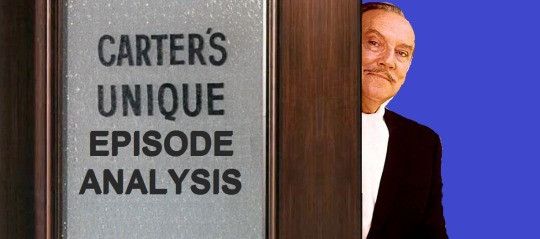
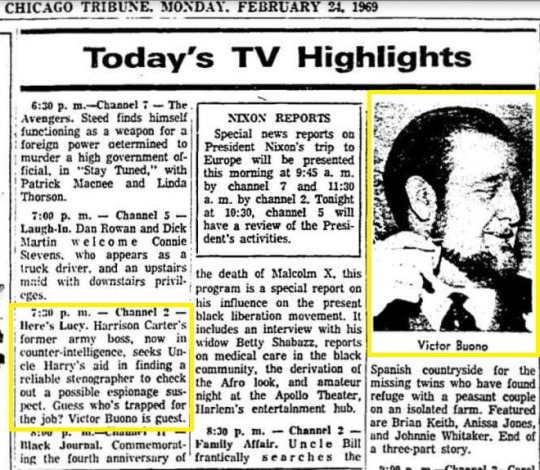
Chicago Tribune, February 24, 1969
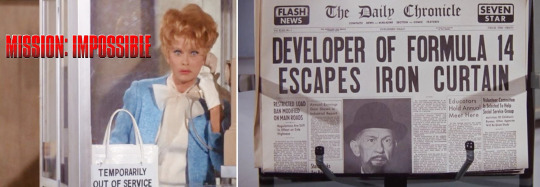
This is the third spy story on “Here’s Lucy” in just five months, preceded by “Lucy's Impossible Mission” (S1;6) and “Lucy and the Great Airport Chase” (S1;E18). Spy series' such as “Get Smart” and “Mission: Impossible” were tremendously popular at the time. Craig mentions a show called “Spy Mission” and Kim talks about “Counter Agent,” both made-up TV spy programs.
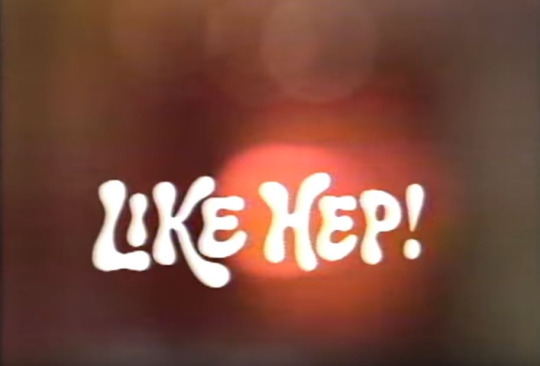
Lucille Ball and Victor Buono were both featured in “Like Hep!”, a Dinah Shore special that aired a few months after this episode. In it, Ball did a variety of sketches, including one set in a speakeasy with Buono as a mob boss.
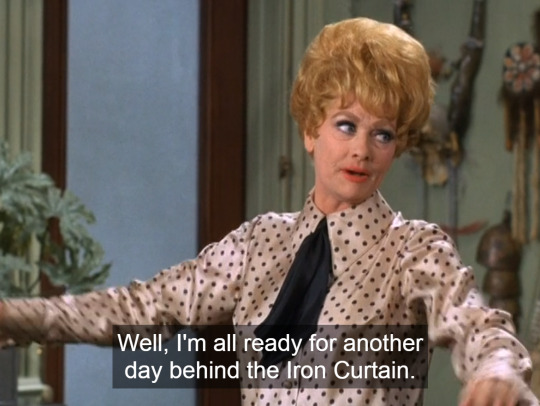
Upon arriving at work, Lucy off-handedly says “another day behind the iron curtain.” The Iron Curtain was the name for the imaginary boundary dividing Europe into two separate areas from the end of World War II in 1945 until the end of the Cold War in 1991. The use of the term contributes to the spy nature of the story, but seems a bit precipitous considering the plot has yet to be revealed!
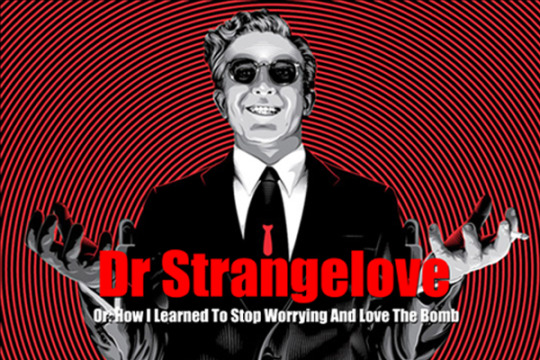
Isabel calls Harry Jack the Ripper, comparing him to the famous London serial killer. There was also a character named Jack D. Ripper in the 1964 iron curtain comedy Dr. Strangelove. Could this be another vague and precipitous reference to the episode’s theme?
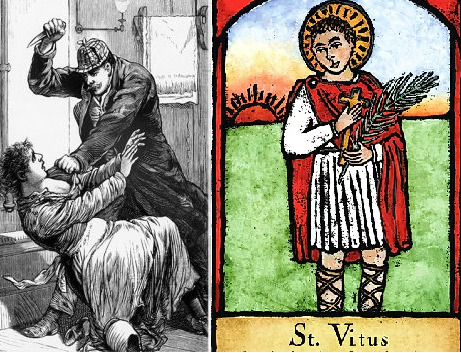
After Isabel and Harry continually bump into one another going out the door (doing a sort of ‘after you’ dance) Harry calls her St. Vitus. Saint Vitus (290-303 AD) was a child saint from Sicily. In the late Middle Ages, people celebrated the feast of Vitus by dancing before his statue. The name "Saint Vitus Dance" was given to neurological disorders like epilepsy. It also led to Vitus being considered the patron saint of dancers.
We learn that Harry was an Army major during World War II and worked at the Pentagon.
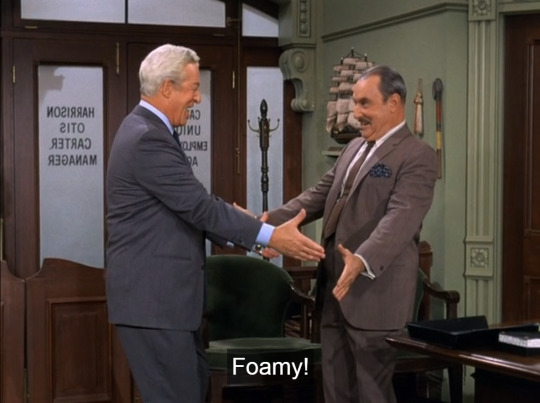
Buzzy calls Harry 'Foamy' because he wore out twelve foam rubber cushions on his swivel chair. Clearly Buzzy and 'Foamy' (aka Harry) were desk jockeys during the war. The script doesn't specify, however, why Buzzy is named Buzzy.
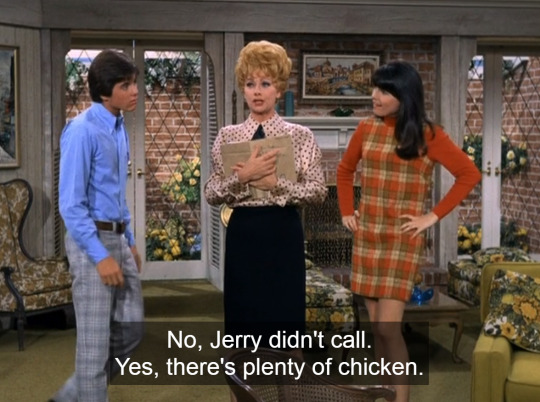
When Kim comes home from school, she asks her mother if Jerry called. Presumably, Jerry is her boyfriend. Jerry was also the name of Lucy Carmichael's son on “The Lucy Show.” She uses her childrens’ questions as a memory test for her upcoming spy assignment.
Kim says her birthday is the 17th of next month. In real life, Lucie Arnaz's birthday is the 17th of July.
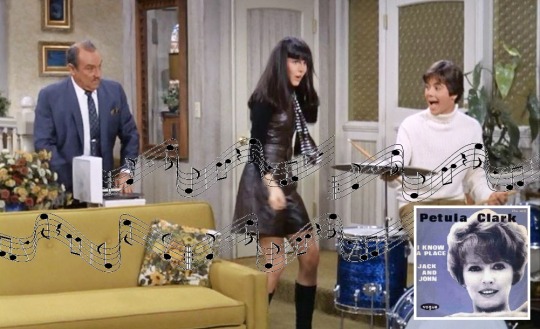
The song Kim and Craig play for Uncle Harry, to show him what life with teenagers in the house might be like, is a jazzy version of “I Know A Place” by Tony Hatch. The song was recorded in 1965 by Petula Clark. It is here performed without lyrics with Kim dancing and Craig playing the drums. Lucy danced to the song in “Mod, Mod Lucy” (S1;E1). Clark will do a guest appearance on the series in season 5, although she will not sing “I Know A Place.”
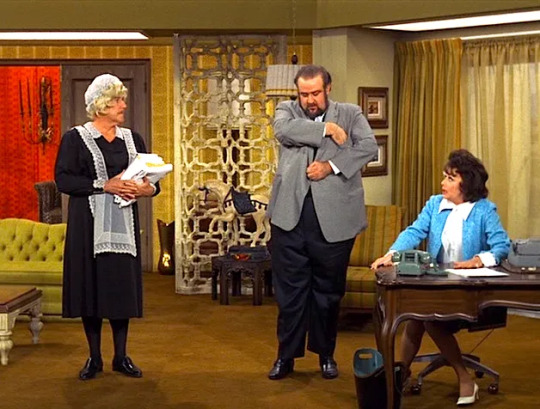
When Lucille Ball enters Vermillion's hotel suite at the (fictional) Crescent Palms Hotel wearing a black wig, she gets a round of applause from the studio audience.
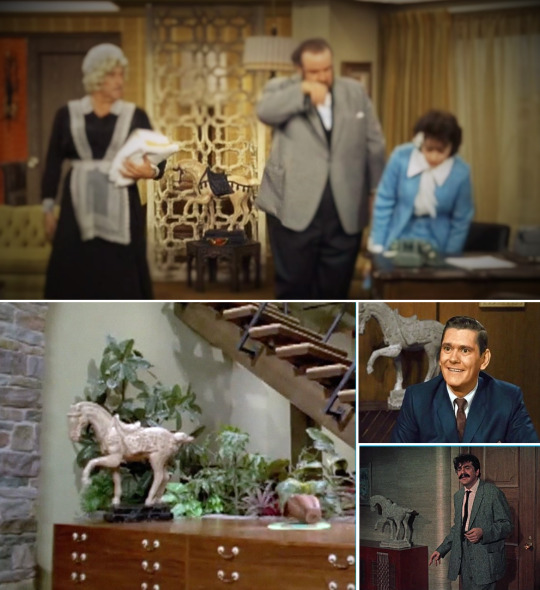
If the horse statue in Vermillion’s hotel room looks familiar, it is likely the same horse used later that year on the set of “The Brady Bunch” (1969-74). Both shows were filmed at Paramount Studios. Similar horses also turned up on “Bewitched” (1964-72) and in the film Bell, Book and Candle (1958) starring Ernie Kovacs. This iteration of the horse statue has its saddle and reigns painted black, but they are otherwise identical. Equine statuary was quite common in mid-century decorating.
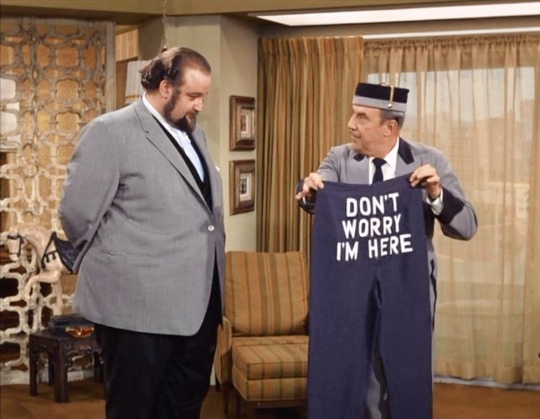
Vermillion, under the guise of a greeting card writer, dictates correspondence to
Gregory Schmidt, General Delivery, St. Louis, Misery
and another to
Igor Shaffsky, Hotel Scimitar, Istanbul
He eats his notes. Is he really a spy or just really hungry?

When Vermillion looks around the room to see that they he and Lucy are alone, the soundtrack plays “Mission: Impossible” style music. The TV score by Lalo Schifrin was extensively used in “Lucy's Impossible Mission” (S1;E6).
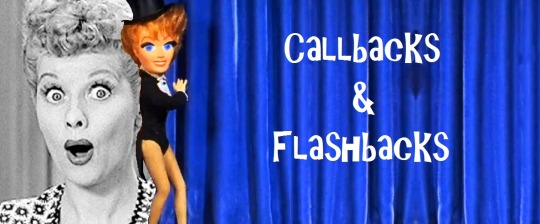
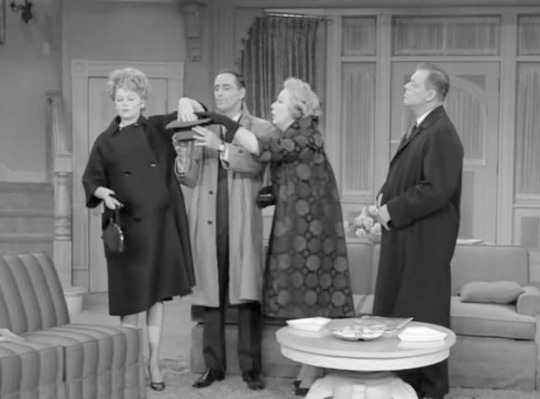
Victor Buono is best known for his role in the Bette Davis / Joan Crawford 1962 horror film What Ever Happened to Baby Jane, a movie that was mentioned on “No More Double Dates” (TLS S1;E21). Lucy Carmichael rejected the film for date night as “too scary”. Coincidentally, both shows were the 21st aired episodes aired in their first seasons!
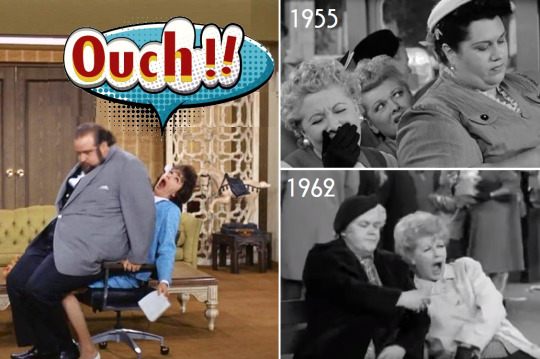
This is not the first time Lucy has mined humor from being sat on by a larger actor. She was underneath a tubby tourist (Audrey Bentz) in “The Tour” (ILL S4;E30) and a girthy granny (Reta Shaw) in “Lucy Misplaces $2,000″ (TLS S1;E4).
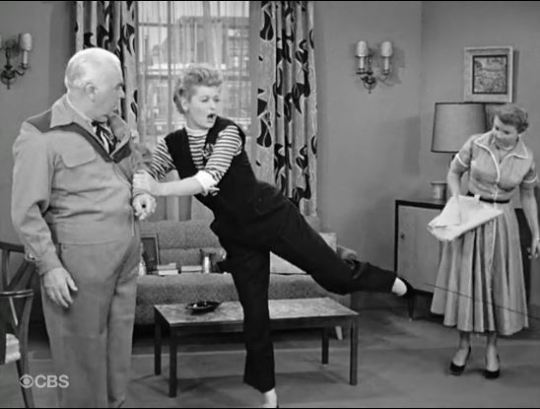
Lucy Ricardo also “wore a wire” when trying to record a confession by who she thought was a Texas oil swindler in “Oil Wells” (ILL S3;E18). Both times her urge to be wired for sound was misguided.
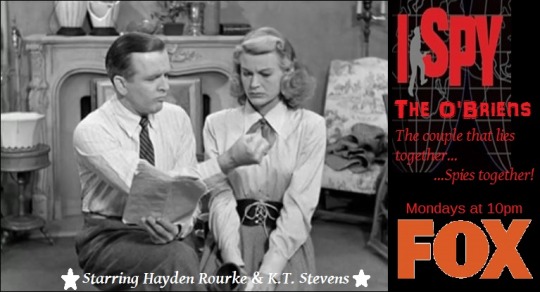
Thinking they were enemy agents, Lucy Ricardo also spied on the “New Neighbors” (ILL S1;E21). Like Vermillion, the O'Briens were not who Lucy first assumed they were but they sure talked a good game!
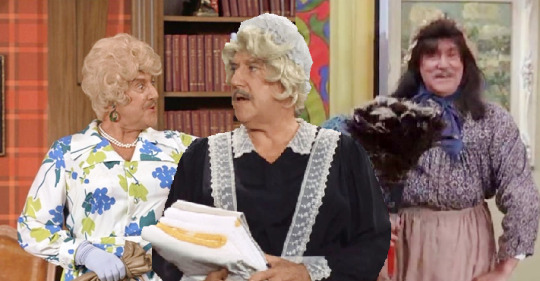
This is not the first, nor the last, time Gale Gordon will get into unconvincing drag without shaving off his mustache!
FAST FORWARD!
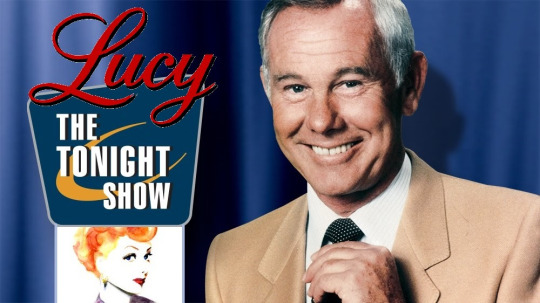
On August 16, 1971, Victor Buono and Lucille Ball were both guests on “The Tonight Show with Johnny Carson”. Kaye Ballard was the musical guest.
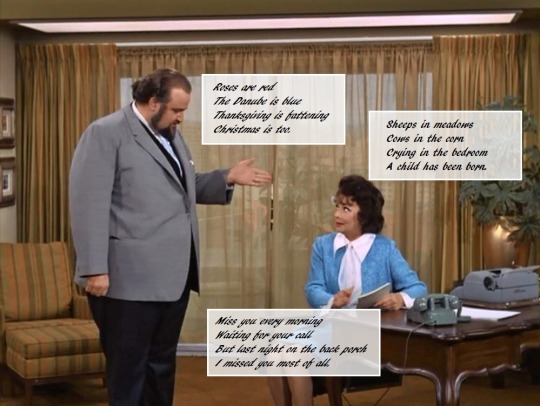
Vermillion is not the last character to be a writer of greeting card verses...
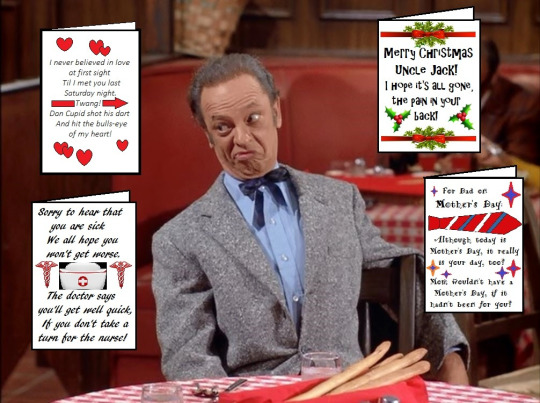
It would also be the occupation of Ben Fletcher (Don Knotts) when “Lucy Goes on Her Last Blind Date” (S5;E16).
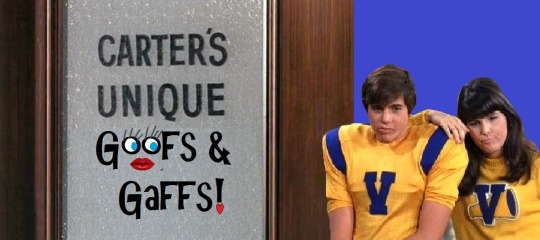
Sitcom Logic Alert! Craig just happens to own a pocket-sized miniature tape recorder. Doesn’t every teenager in 1969?
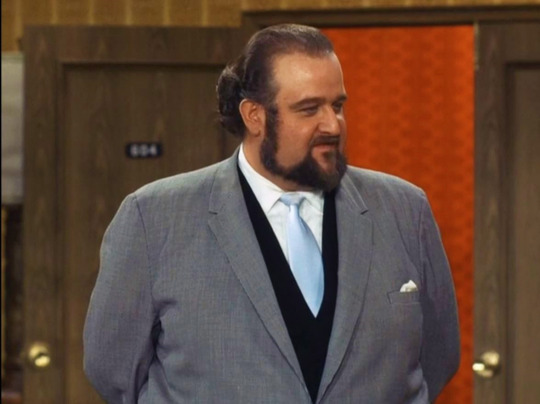
Color Blind! Vermillion tells Harry (as the Bellboy) that he “never wears blue” yet he is clearly wearing a powder blue tie. Is he just trying to get rid of Harry through intimidation?
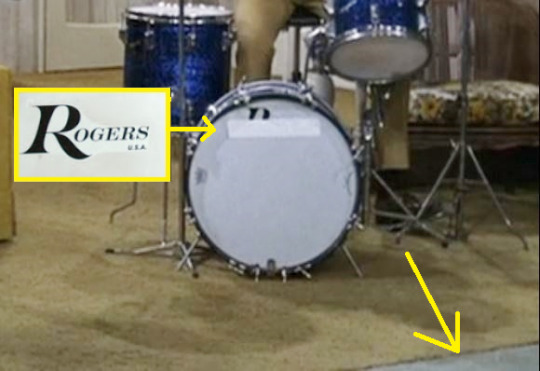
Product Dis-Placement! The brand name of Craig’s drum set is partly taped over. The top loop of the ‘R’ reveals that it is made by Rogers. Founded in 1849 in Farmingdale, NJ, by Joseph Rogers, the company went out of business in 2006.
Where the Floor Ends! In the lower right corner of the above screen shot, viewers get a glimpse of where the Carter’s wall-to-wall carpet ends and meets the cement stage floor!

“Lucy Gets Her Man” rates 3 Paper Hearts out of 5
A nearly five minute scene without Lucille Ball, when Kim and Craig convince their Uncle Harry to keep an eye on their mother, is a bit awkward and too long. Mary Wickes is given virtually nothing to do in this episode. Her lines could just as well have been spoken by an uncredited day player. Lucille Ball's scene with Victor Buono, however, is quite good and Gale Gordon in maid drag (with his trademark mustache) is well worth the wait. The surprise ending actually makes sense and is very funny, if a bit abrupt.
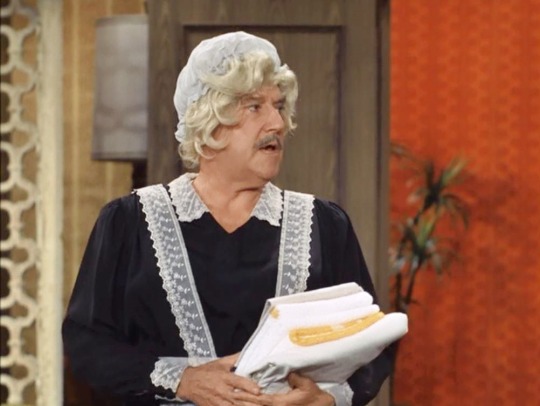
“Ja. Yust like mama!”
#Here's Lucy#Lucy Gets Her Man#Lucille Ball#Gale Gordon#Lucie Arnaz#Mary Wickes#Desi Arnaz Jr.#Victor Buono#drag#I Know A Place#spy#Robert Carson#Jack the Ripper#Saint Vitus#Iron Curtain#King Tut#What Ever Happened to Baby Jane#Lalo Schifrin#Mission Impossible#TV#1969#CBS
5 notes
·
View notes
Photo
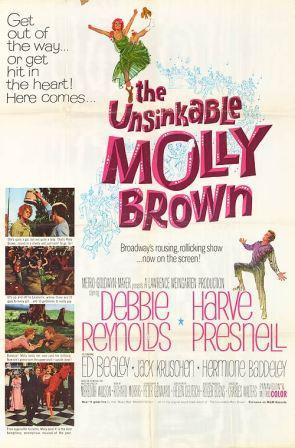
New Post has been published on http://www.classicfilmfreak.com/2017/01/12/unsinkable-molly-brown-1964-debbie-reynolds-harve-presnell/
The Unsinkable Molly Brown (1964) with Debbie Reynolds and Harve Presnell
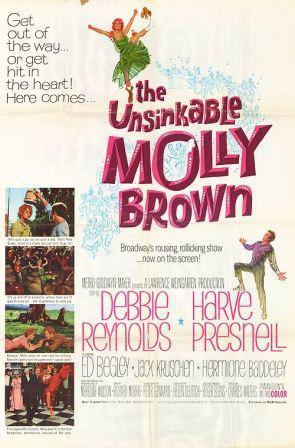
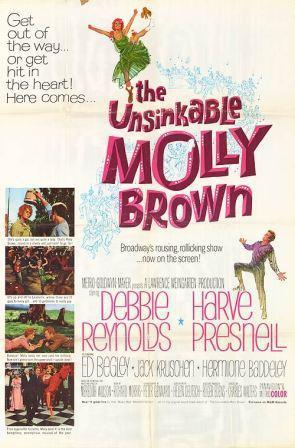
“Sure, I may be tuckered, and I may give out, but I won’t give in.”— Molly Brown
Quality Hollywood movies somehow increased in 1964, and one of the best years of the decade offered a little more variety than usual. Dr. Strangelove shocked as an imaginative black comedy about two superpowers on the brink of world destruction and The Night of the Iguana did its own shocking with alcoholism and repressed—and expressed—sexual passions. Becket as a serious historical, Shakespeare-like drama portrayed a king and his wayward archbishop and Zorba the Greek made high cinema of an earthy peasant. The Pink Panther offered the greatest contrast of the four; to an unsuspecting world, it introduced the bumbling Inspector Clouseau and his personification in one Peter Sellers.
Being in the center of a decade of extravagant musicals, 1964 alone produced three competitive song and dance films—Mary Poppins, My Fair Lady and The Unsinkable Molly Brown. In most of the Oscar categories two of them, sometimes all three, were nominations. When a musical won, which was thirteen times, it was never The Unsinkable Molly Brown.
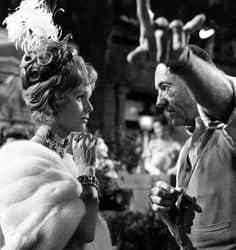
And its nominated Best Actress star, Debbie Reynolds, lost to the favorite, Julie Andrews, for Mary Poppins. It would be Reynolds’ only Oscar nomination, though she received the Jean Hersholt Humanitarian Award at the 2015 Oscar ceremonies, February 28, 2016, belatedly extended by the Academy, as usual for elderly, Oscar-less stars. But even that was none too soon, for Reynolds died on the twenty-eighth of another month, December 2016.
She is perky and high-stepping in Singin’ in the Rain (1952), easily her most popular and best film, and one of the greatest musicals of all time. Untrained as a dancer, Reynolds was highly tutored by Gene Kelly, co-director with Stanley Donen. She shared her choreographic routines with another light-footed elf, Donald O’Connor, and no one would have ever imagined she wasn’t a professional dancer from the start.
In The Unsinkable Molly Brown, music and lyrics by Meredith Willson, she is more than a mere “high-stepper”: she is a keg of dynamite about to explode. She is loud, common and vulgar, until she transforms her character into a lady—well, only partially—and seeks a place in the upper echelons of society. There, at first, she finds only snobbery and exclusion, but determined—and “unsinkable,” as it will prove—she triumphs and receives all she ever desired during her poverty days.
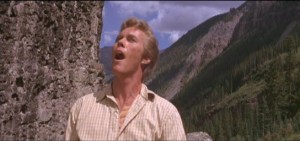
Although Debbie Reynolds’ supporting cast members are all competent and throw themselves with wild abandon into some of the crazy antics of the film, she has only one serious co-star, one fellow singer of stature, Harve Presnell. There is obvious chemistry between her and this six-foot-five-inch, gangling actor, who never competes with but compliments Reynolds with his quite different acting and singing style.
Unfortunately, Presnell’s career faltered in the closing years of the decade, when the vogue for musicals, reaching a pinnacle with The Sound of Music in 1965, was fading, at least for a while. Doctor Doolittle (1967) and Hello, Dolly! (1969) were among several singing disasters. In Paint Your Wagon(1969), sluggishly directed by Joshua Logan, Presnell is the only professional vocalist among such non-singers as Clint Eastwood, Lee Marvin and Jean Seberg, though she, fortunately, was dubbed (by Anita Gordon).
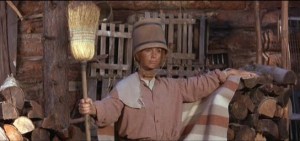
A baby, surviving the rapids of the Colorado River, is adopted by frontiersman Shamus Tobin (Ed Begley, Best Supporting Actor Oscar two years earlier for Sweet Bird of Youth) and given the name Molly (Reynolds). Molly becomes a tomboy, dresses in trousers and a shabby shirt and uses foul language.
Her fight with Shamus’ three sons produces a rip-roaring “I Ain’t Down Yet,” and between lyrics she expresses her philosophy: “I hate the word ‘down,’ but I love that word ‘hope,’ ” and “I mean much more to me than any one I ever knew.” Soon, though, Molly believes it’s time to leave, with two objectives, to learn to read and write and to marry a rich man.
Against a sumptuous mountain landscape, the owner of a gold mine, Johnny Brown (Presnell), bursts into song: “Colorado, My Home.” After happening upon Molly taking a bath in the river, he takes her to his cabin.
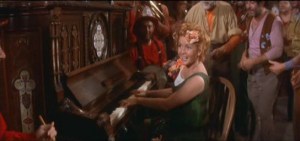
After a brief stay, she goes to Leadville and is hired by saloon owner Christmas Morgan (Jack Kruschen) as a singer and piano-player, though she cannot sing or play. Toying with the keyboard, Molly finds two notes, one in the treble, one in the bass, that comprise her “piano playing,” and she becomes a hit in “Belly Up to the Bar, Boys.”
Johnny buys her some dresses and begins teaching her to read. Under a tree on a knoll, lessons continue and Presnell sings the key song of the musical, “I’ll Never Say No.” The song is the equivalent of “Till There Was You” in Willson’s first musical, The Music Man (1962). For tune detectives, “I’ll Never Say No” uncannily resembles the trio of the scherzo of Brahms’ Horn Trio in E-Flat.
Johnny remodels his cabin, with a room for Shamus and, for Molly, a bedroom with a big brass bed. The couple wed, but she confesses it isn’t what she wants, that there’s still . . . money. He sells his claim for $300,000, but unaware she has hidden it in the stove, he decides to warm himself after a cold bath, and—— No, money doesn’t matter after all, they decide. Johnny tosses a pickax in the air, it strikes a nearby mound of earth and gold trickles out.
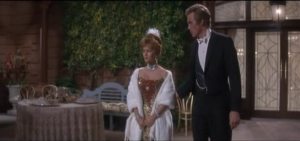
Now back in the money, the Browns buy an enormous mansion in Denver, with a room for Seamus. They introduce themselves to the city’s social elite, crashing the party of Gladys McGraw (Audrey Christie), but they are excluded from the table of the so-called “Sacred 36” of Denver, and the butler closes the door in their faces.
An angry Molly then throws her own party. Nobody comes, though Shamus hits it off with “Buttercup” (Hermione Baddeley), Gladys’ mother. Molly decides the Browns will go to Europe and learn something about art, music and manners.
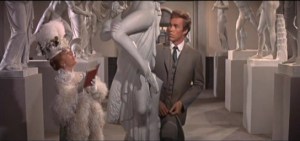
In Paris, they wander through museums, gaze at paintings, stare warily at nude statues and attend the opera. Molly takes piano and French lessons. The royalty like the down-to-earth Molly and she becomes the toast of Parisian society. At a clique fashion show, she meets the Grand Duchess Elise Lupavinova (Martita Hunt, Miss Havisham in Great Expectations [1947]), who winks at her, and becomes a friend.
The couple return to Denver, accompanied by ten of Molly’s aristocratic friends. She intends to show the second-generation society of Denver some real culture. She does well at first. Mrs. McGraw is clearly impressed and shamed to be exposed as only a dilettante of the arts, unable to converse in French or German, paint or play the piano.
But things go awry when Johnny’s friends crash the party, resulting in a long rendition of “He’s My Friend.” Then a fight breaks out, and Molly’s plans for gaining the approval of Denver society are destroyed.
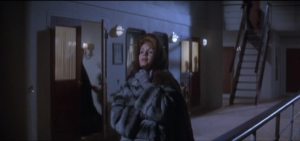
She returns to Europe—without Johnny, who tells her he’s saying “no” for the first time. Before long, she realizes that putting herself before others is wrong and sets sail for home on the Titanic. When the liner sinks, she rescues many of the passengers, giving up her fur coat.
Returning home, now as a headlining heroine, she is accepted by all of Denver, including Mrs. McGraw, and, of course, Johnny.
Margaret, actually “Maggie,” Brown was a real person, born in Missouri and dying in 1932 at age 65, but much of The Unsinkable Molly Brown is far from accurate. Certain liberties are taken, both with the facts of the real Brown and with simple screen logic. It is a musical, after all, so these liberties are expected and can mostly be excused. If it goes on a little too long for the material at hand—the musical has far fewer and less memorable songs than The Music Man—and becomes sluggish at times, it is nevertheless high screen entertainment, typical of the decade, the era and the history of the American musical.
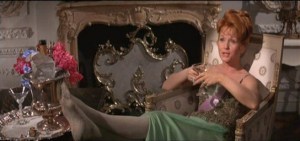
Debbie Reynolds is the star and she takes charge, no doubt about it. Her vitality and sincerity—and her likeability—compensate for the deficiencies in the film. It’s possible to see in her portrayal of Molly a reflection of Reynolds’ own character—determined, someone who knows what they want, a survivor. It’s possible, as well, to see in Molly’s distraught anguish, in that scene before her final departure from Paris, the shattering traumas in the actress’s own life—the scandalous lost of first husband, Eddie Fisher, to Elizabeth Taylor, the bankruptcy of her second husband and the death of daughter Carrie Fisher one day before she herself died of a stroke.
Perhaps, finally, Debbie Reynolds was what Molly Brown called “down,” what she never wanted to be. Perhaps it was more than the actress could take.
https://www.youtube.com/watch?v=Vk10MoMpMIA
2 notes
·
View notes